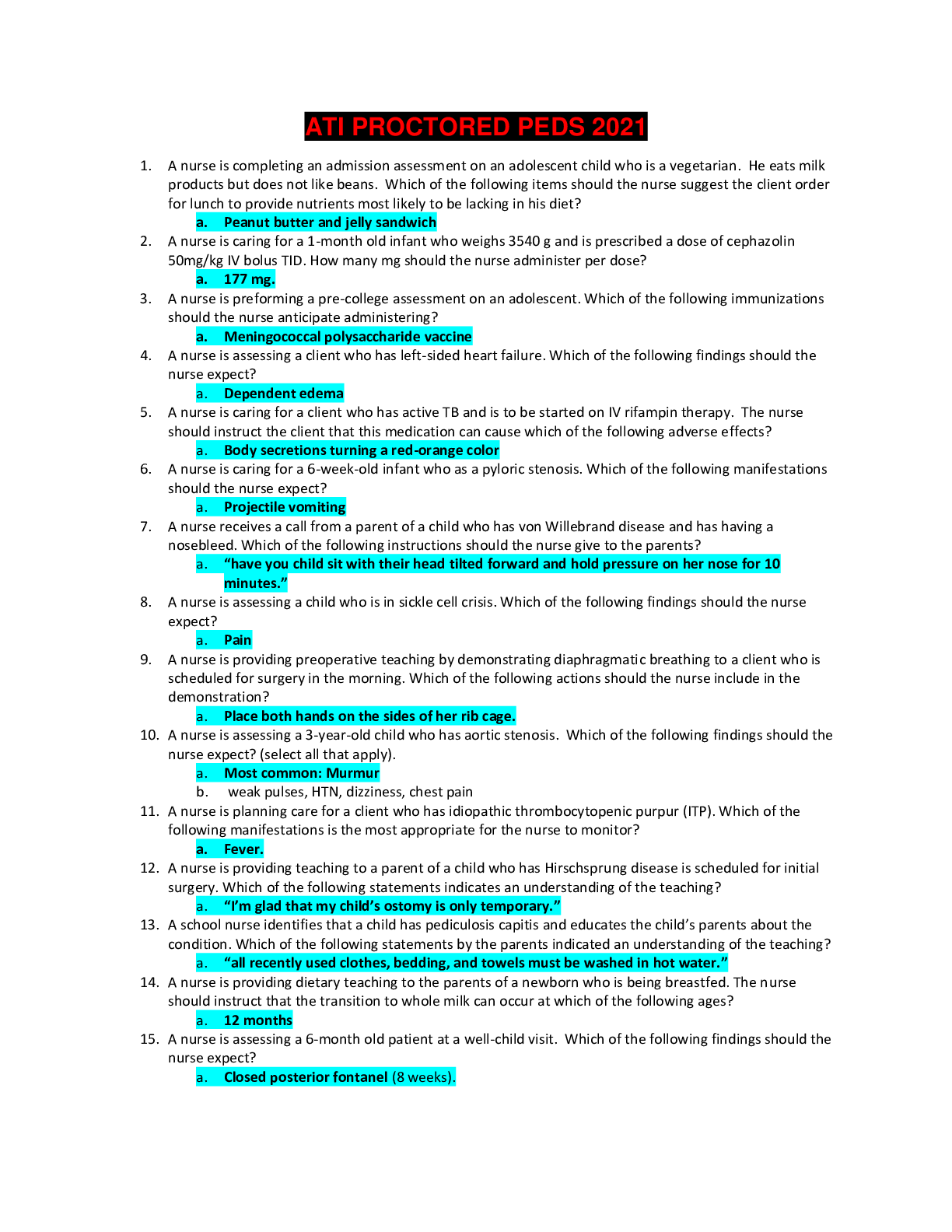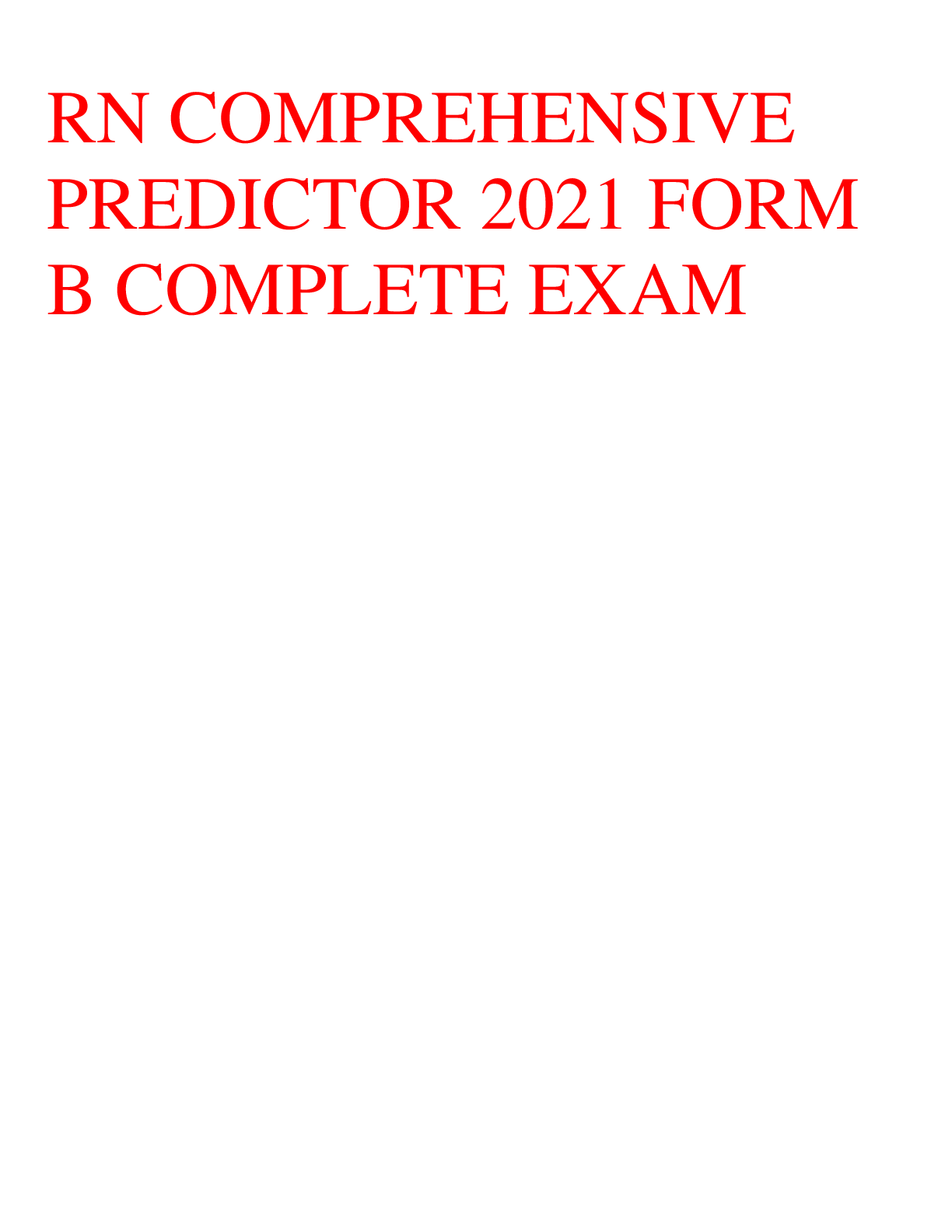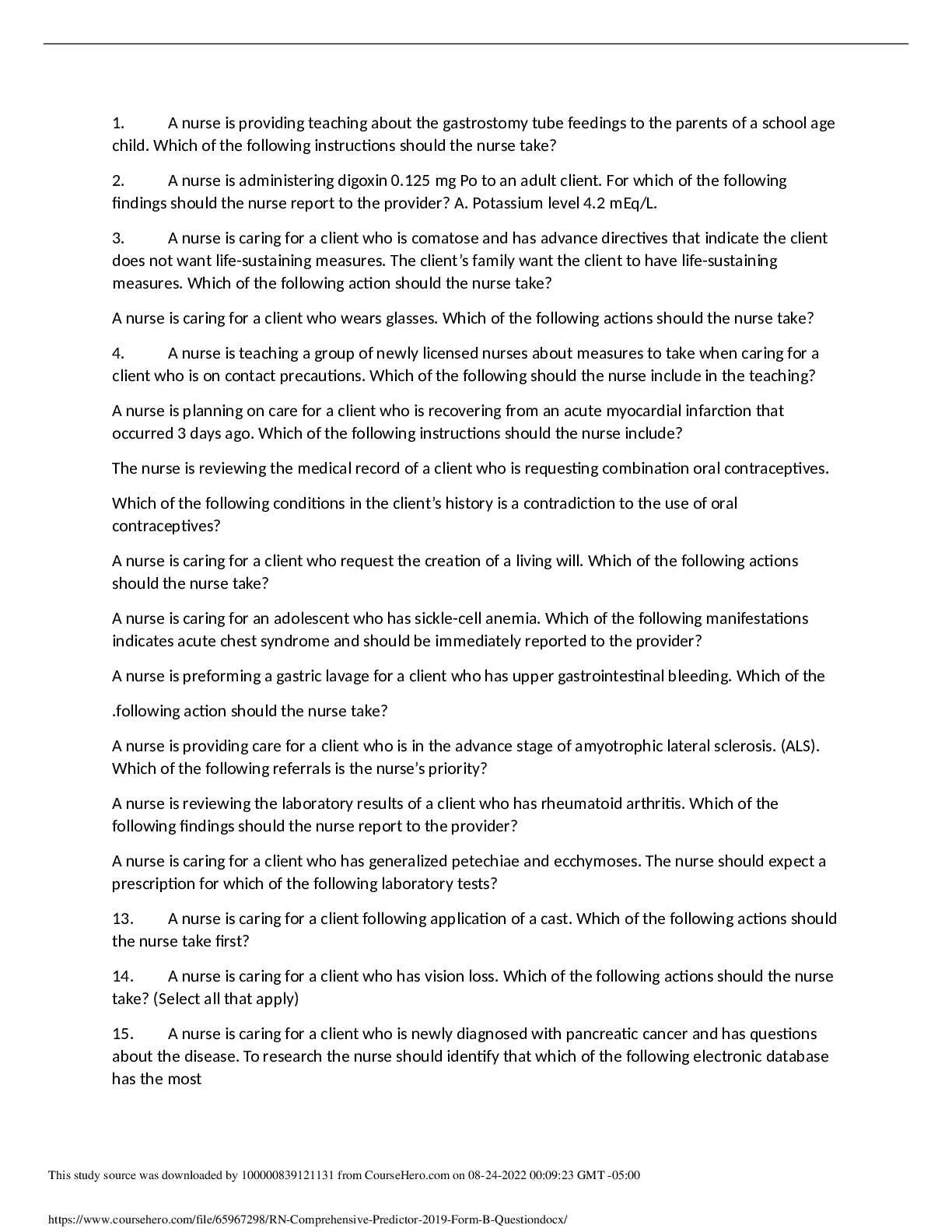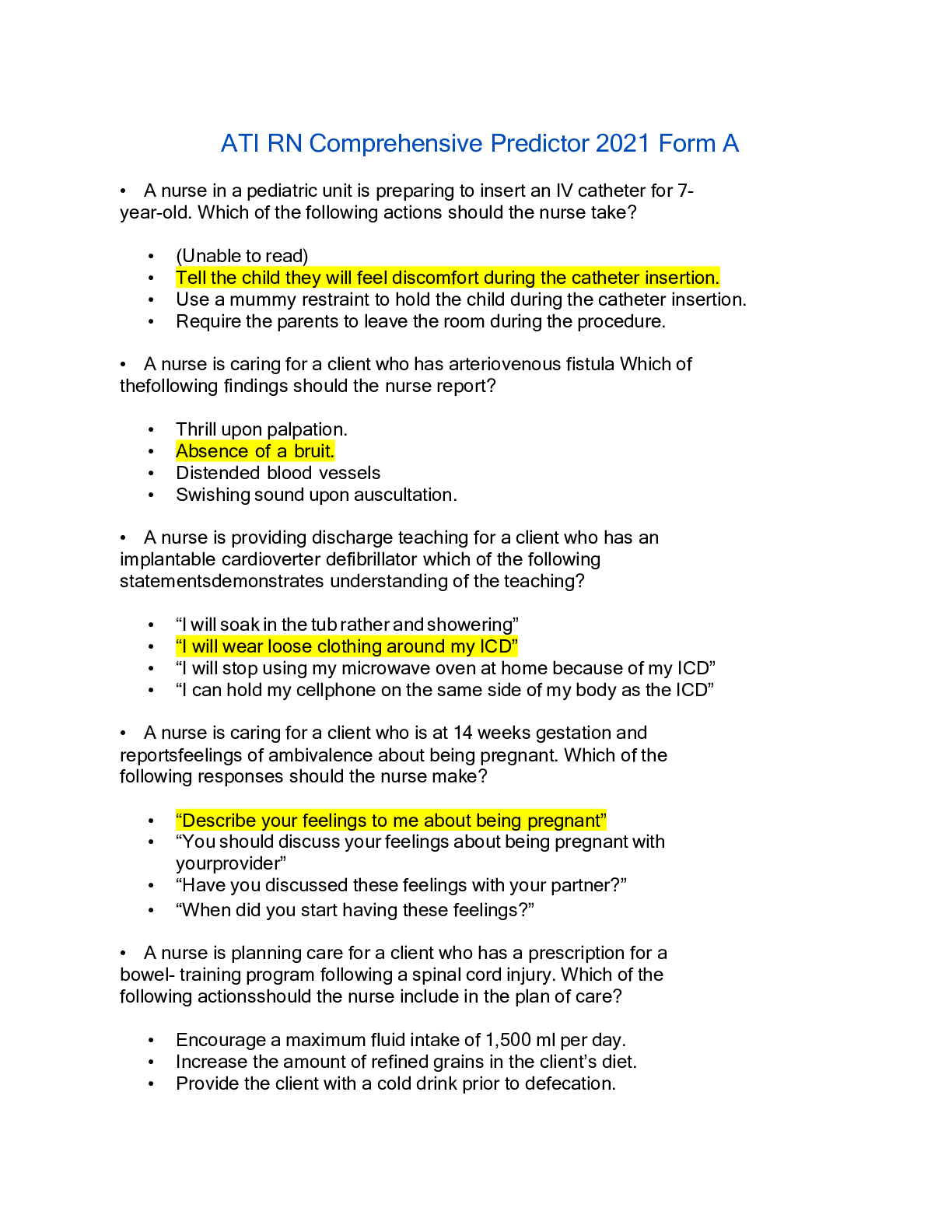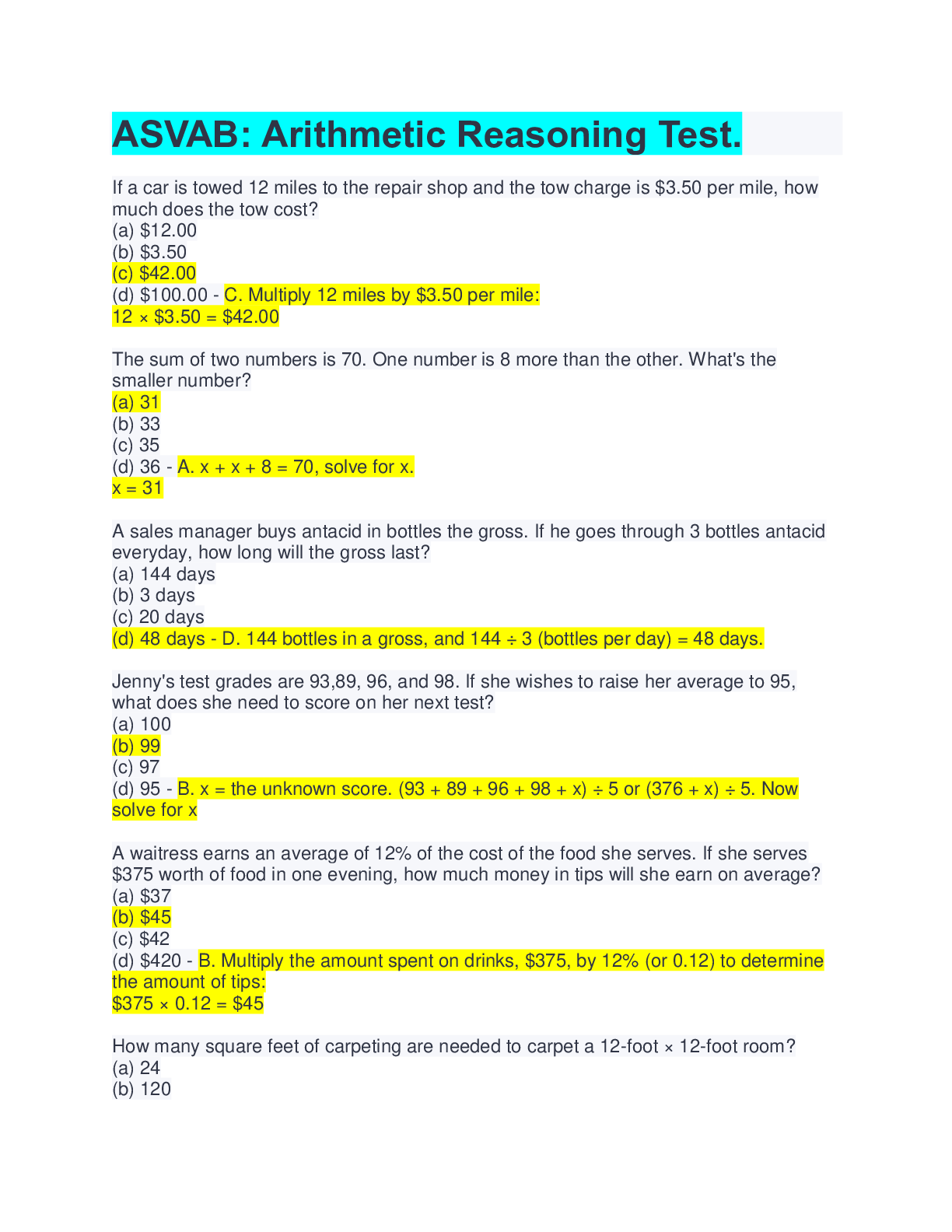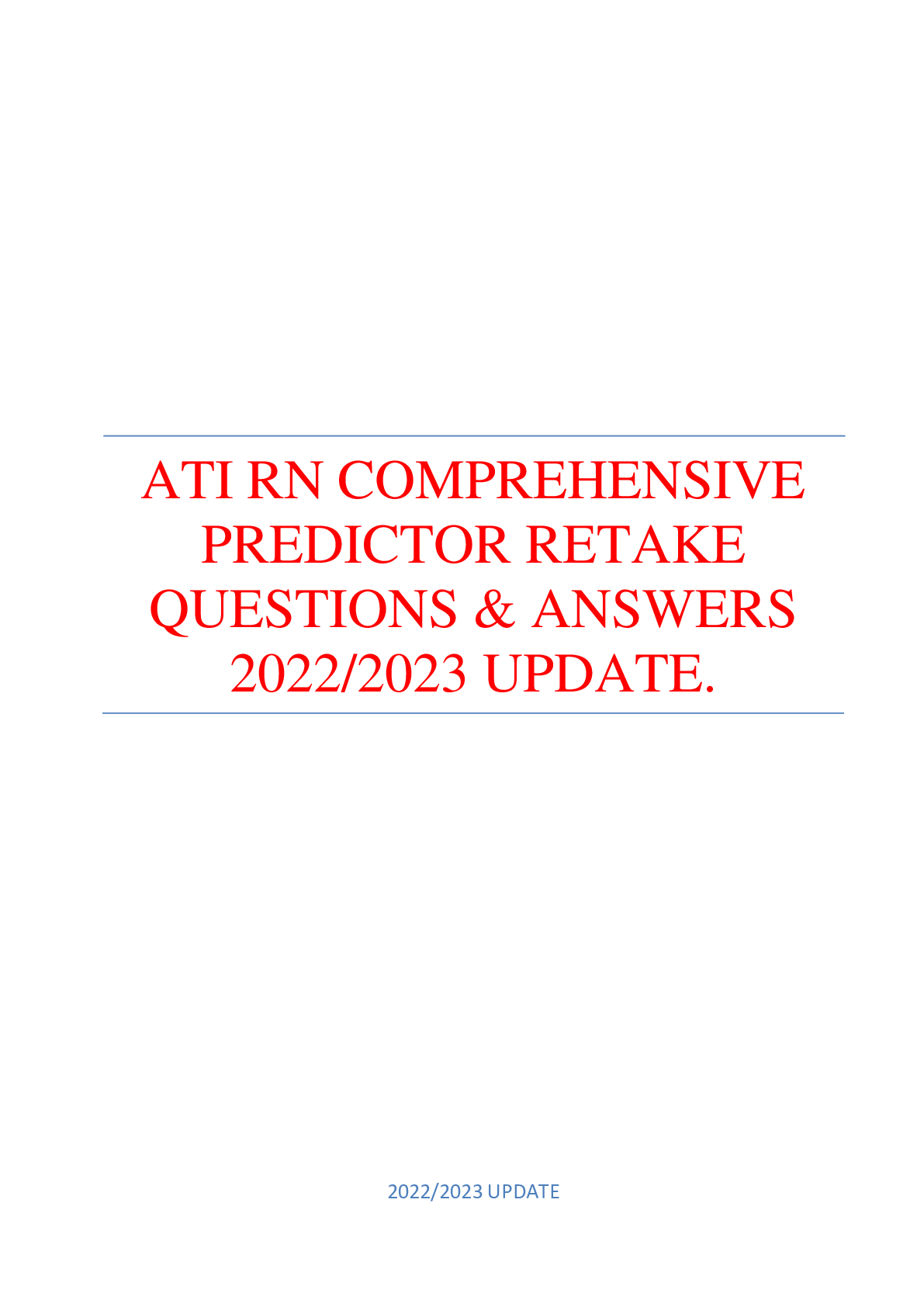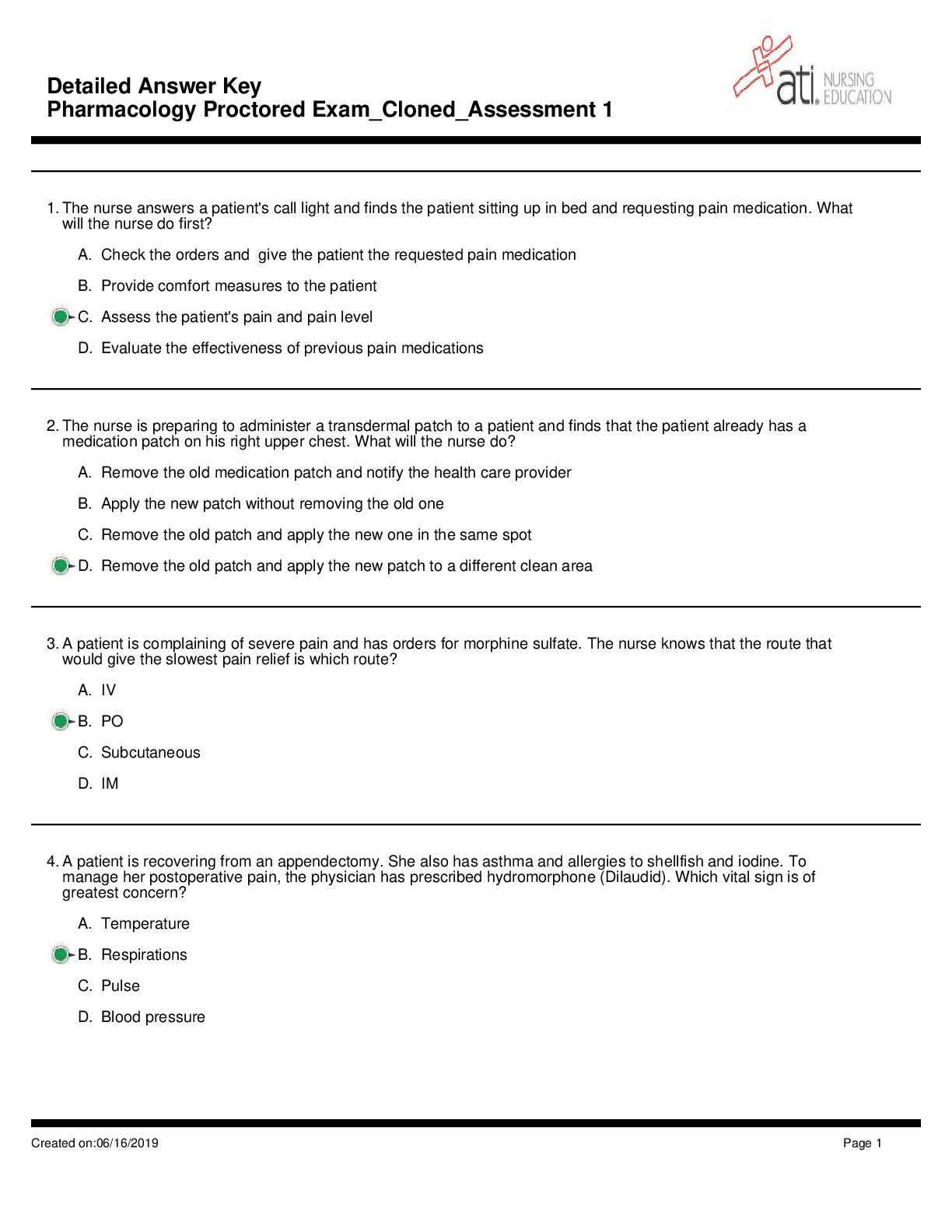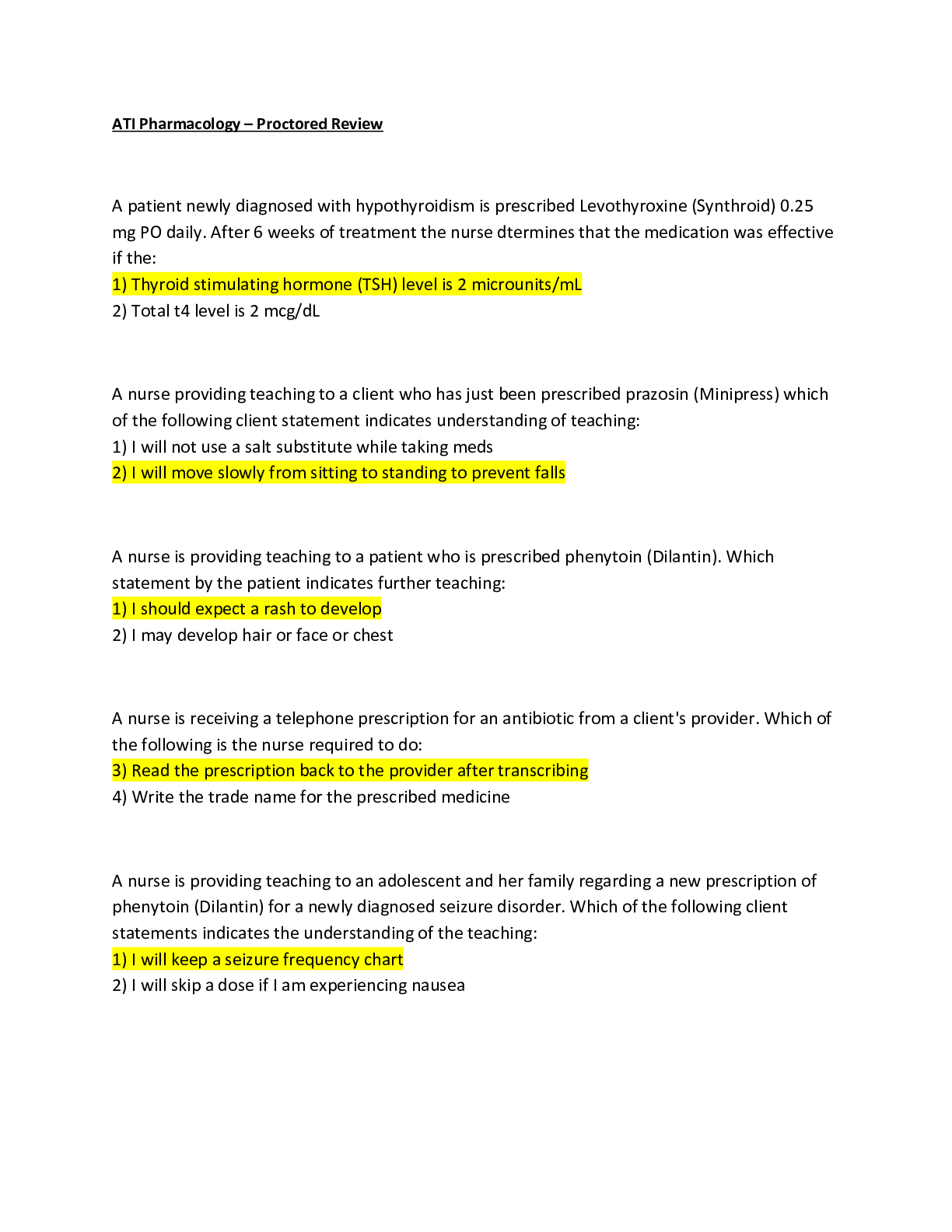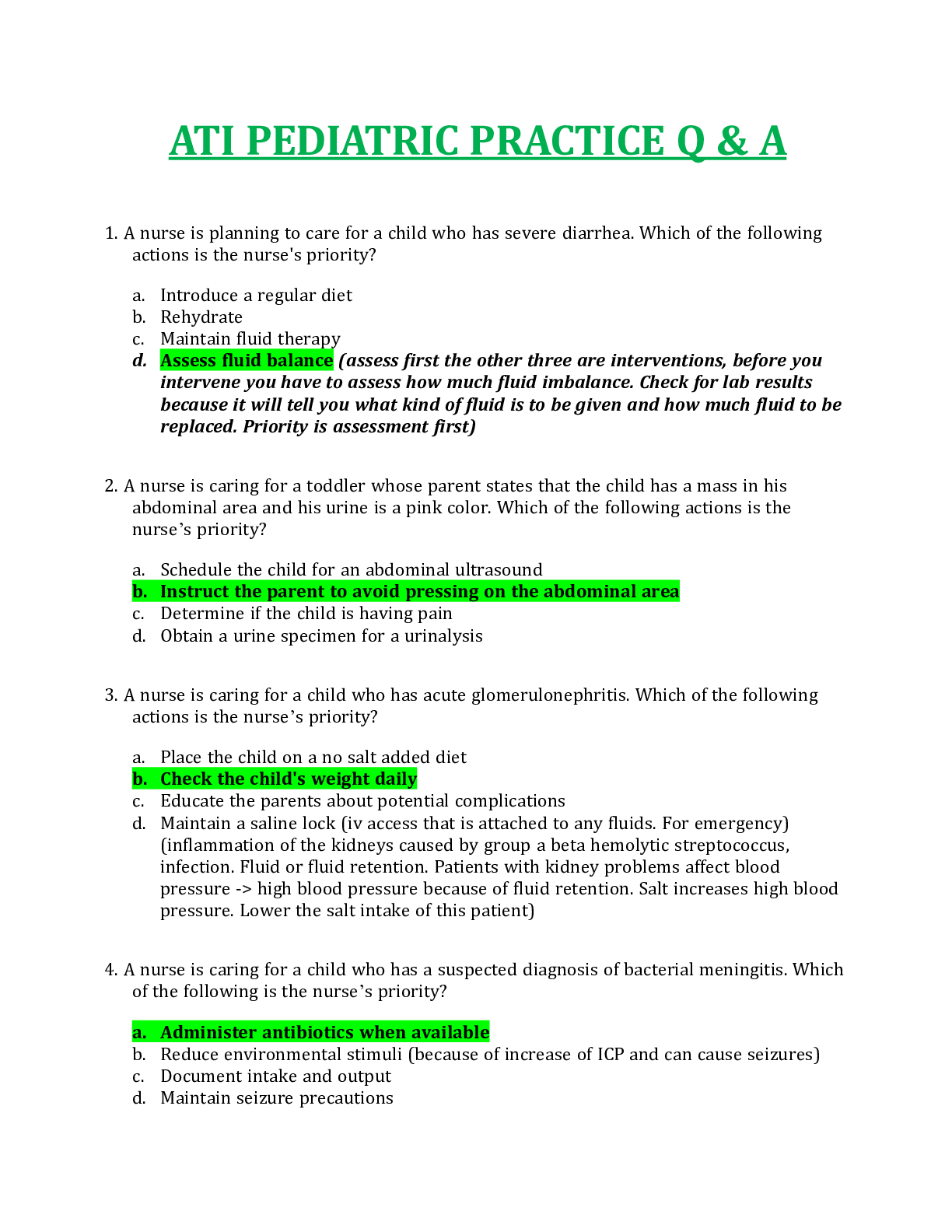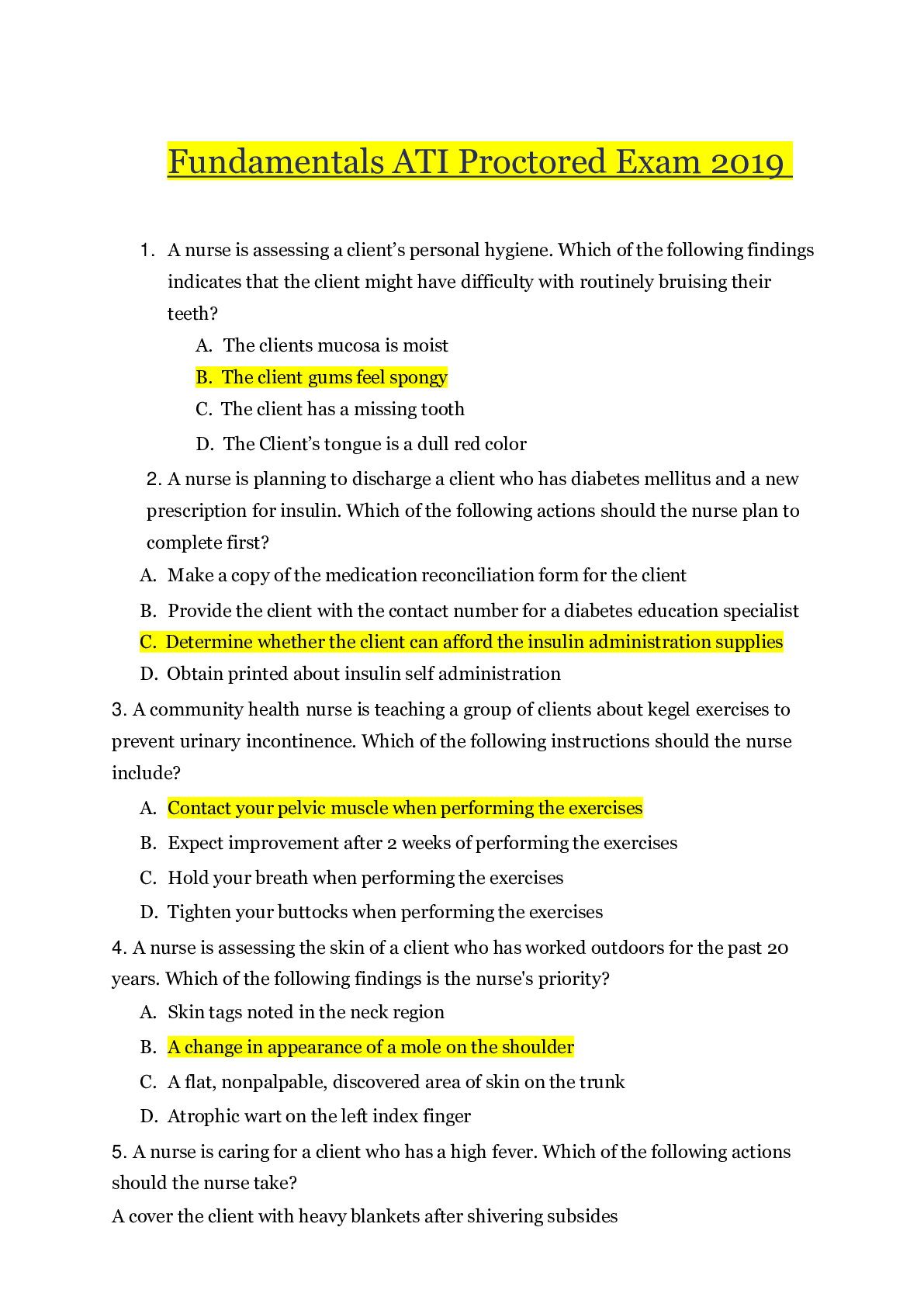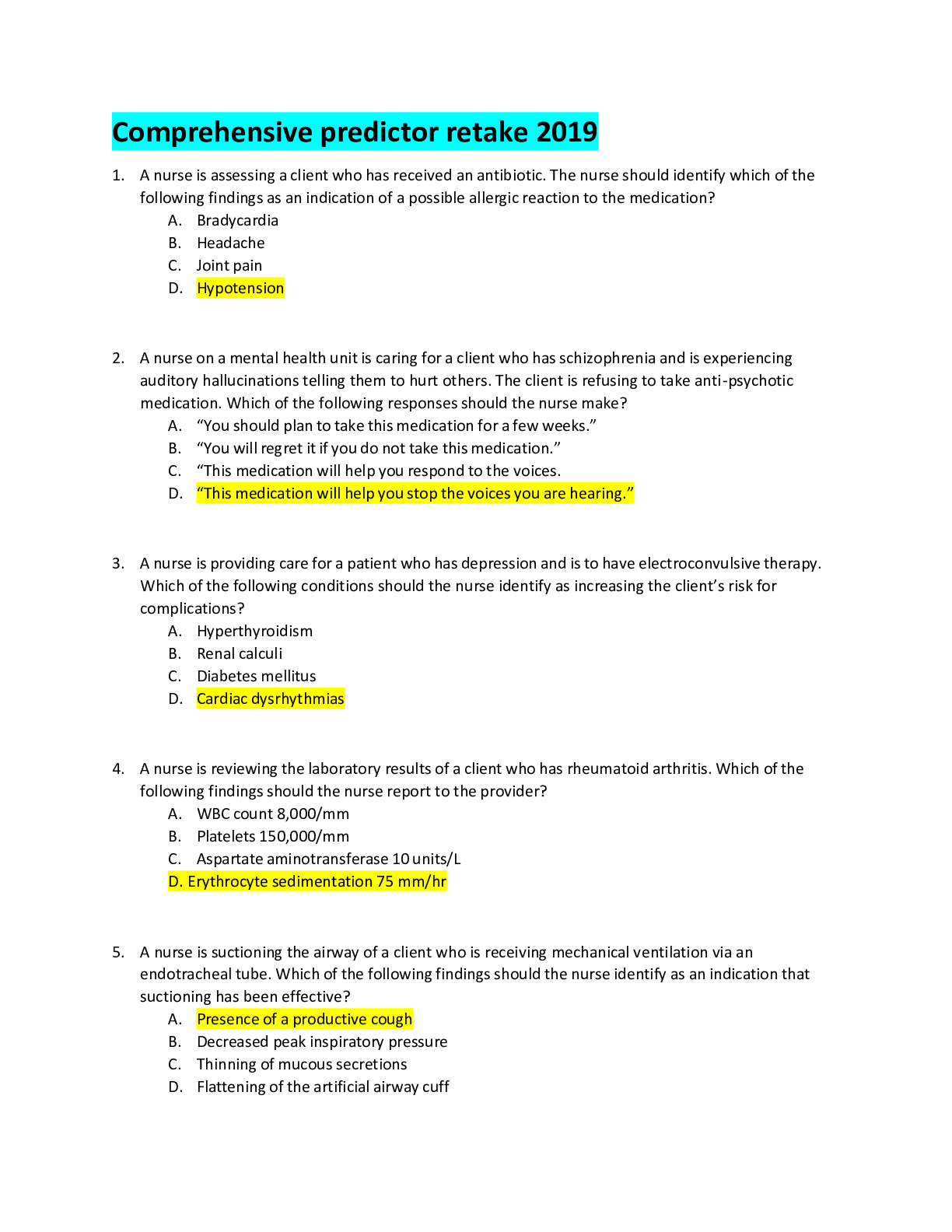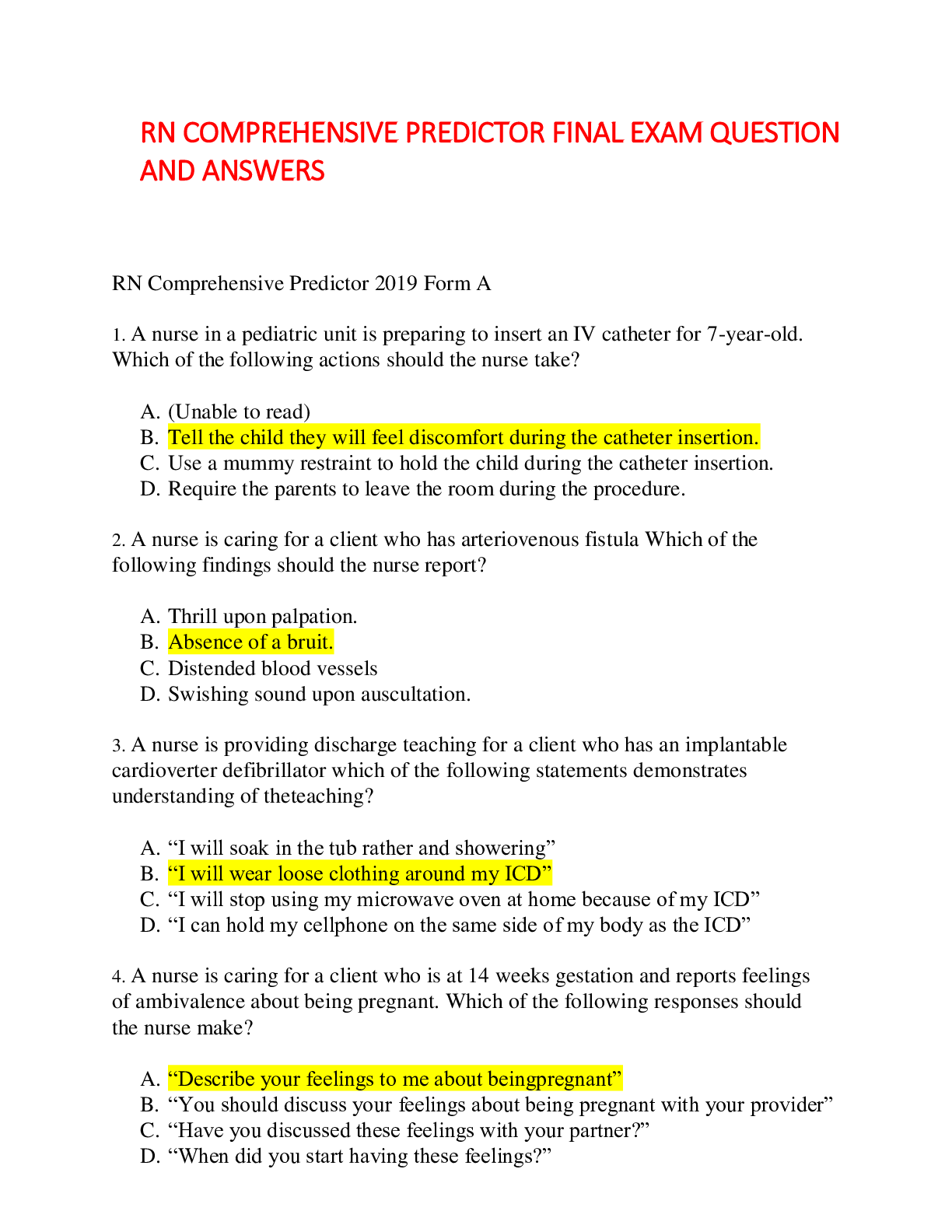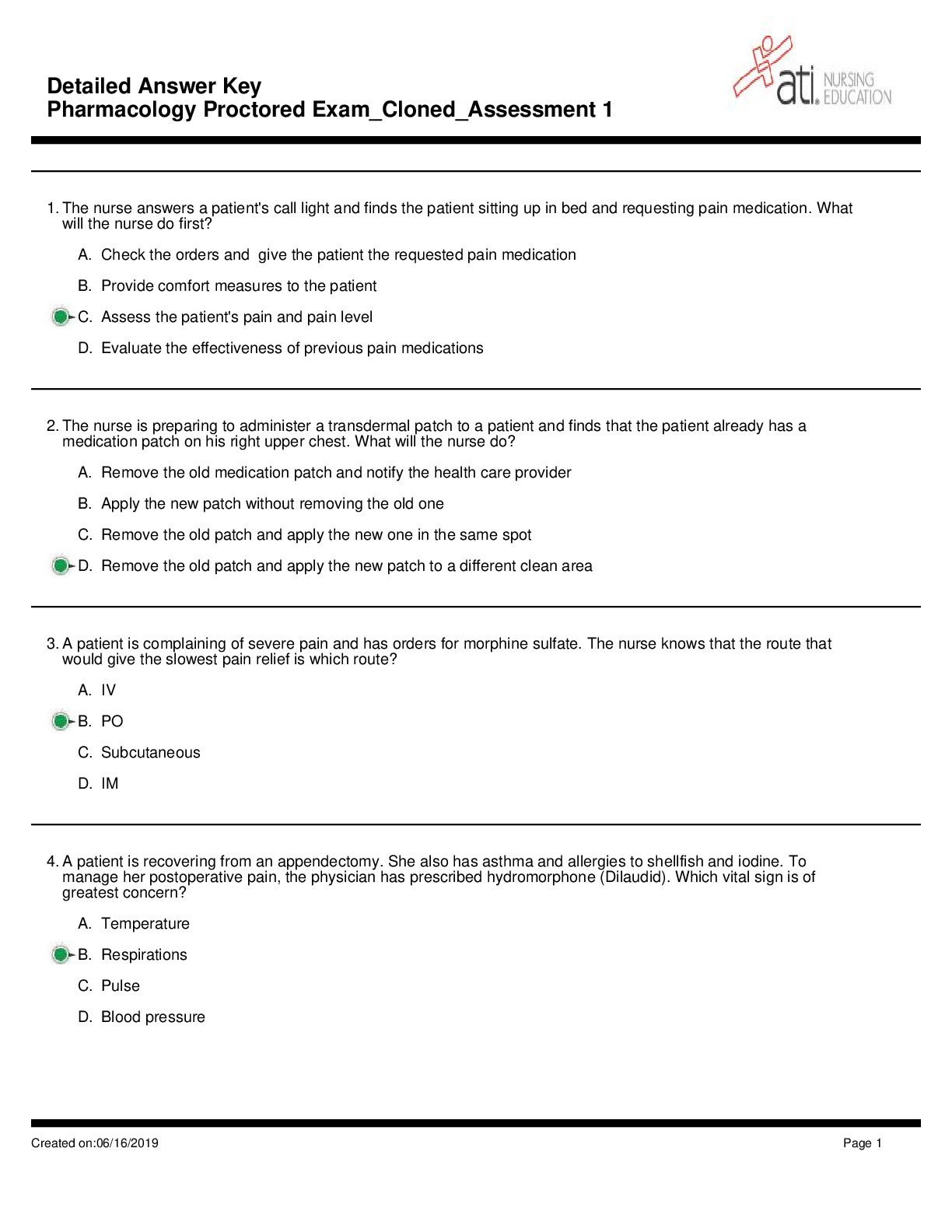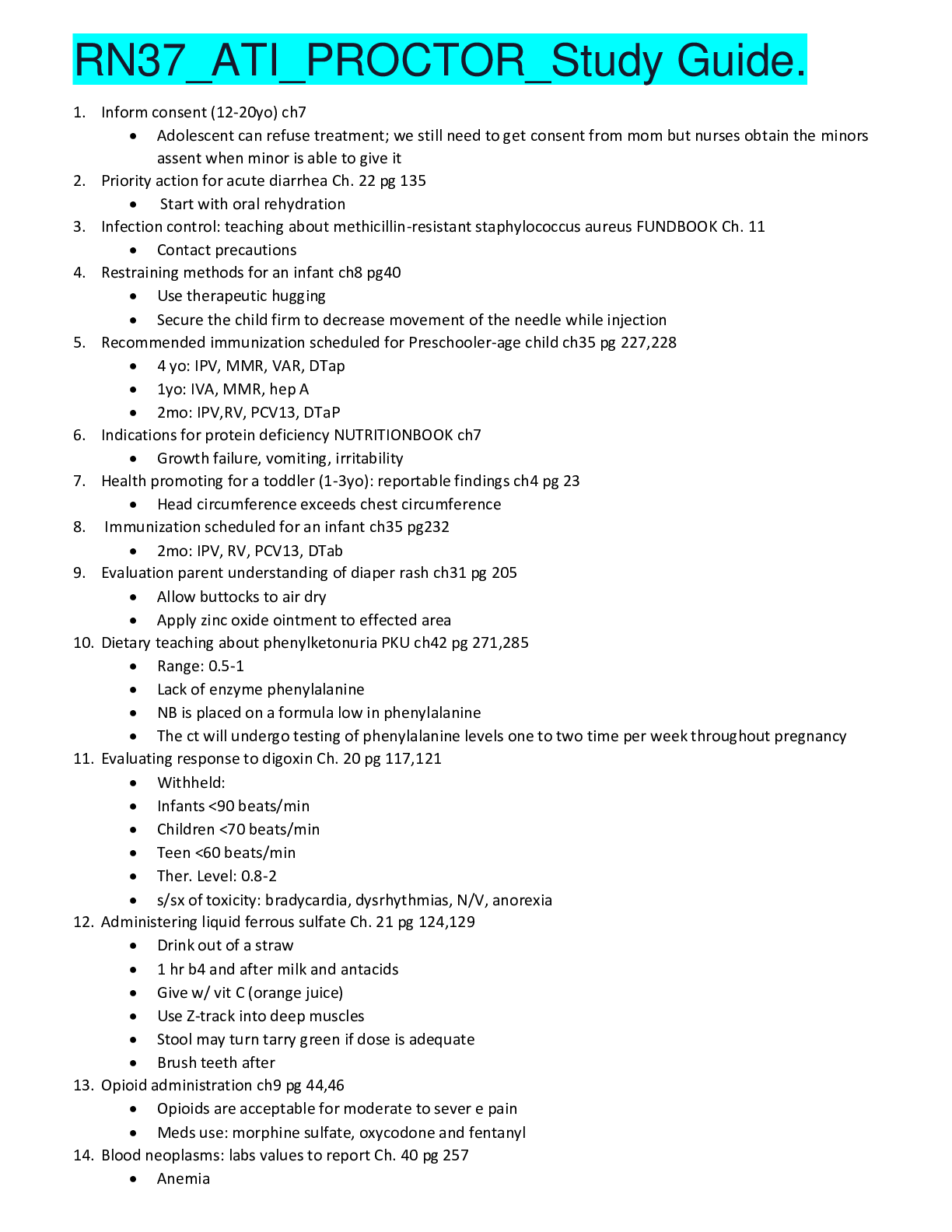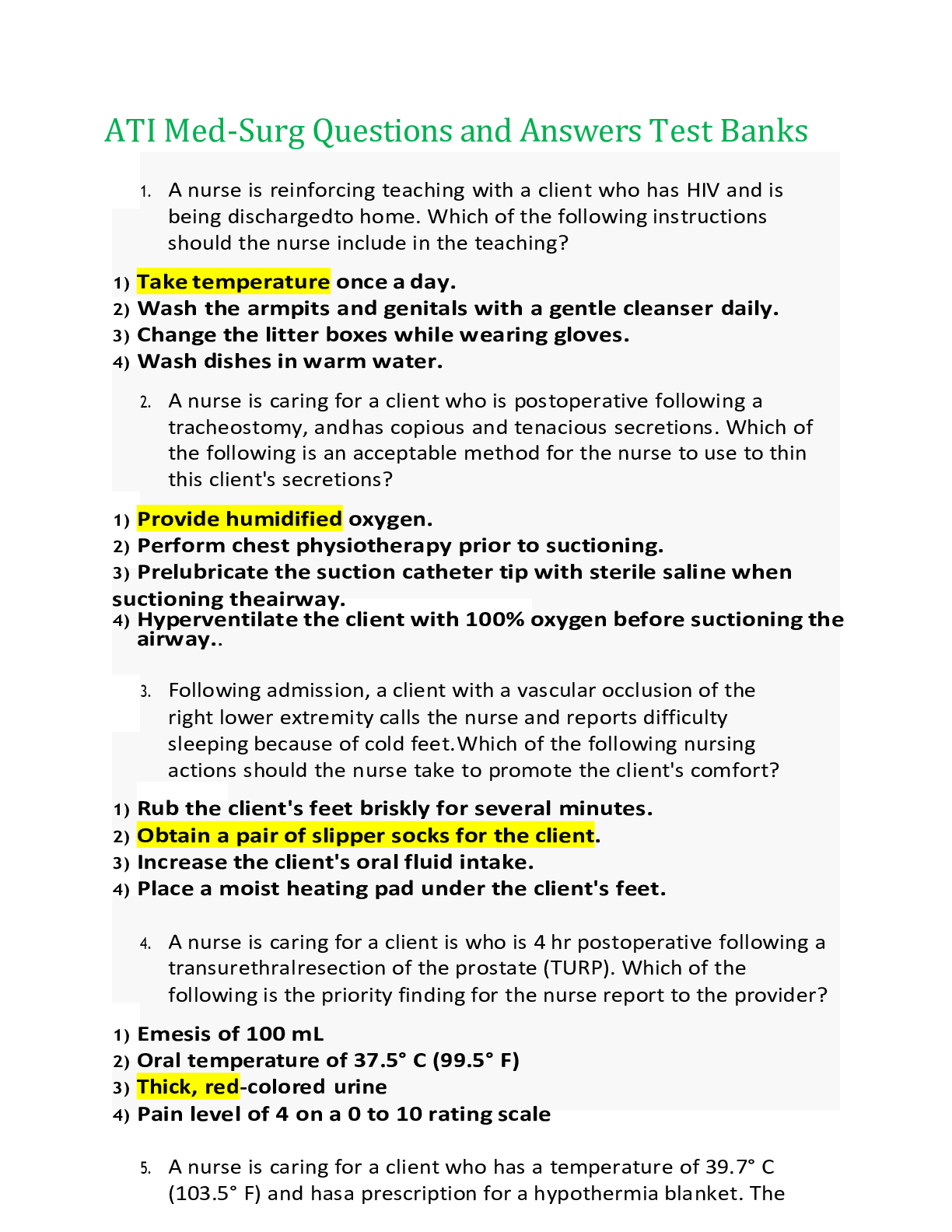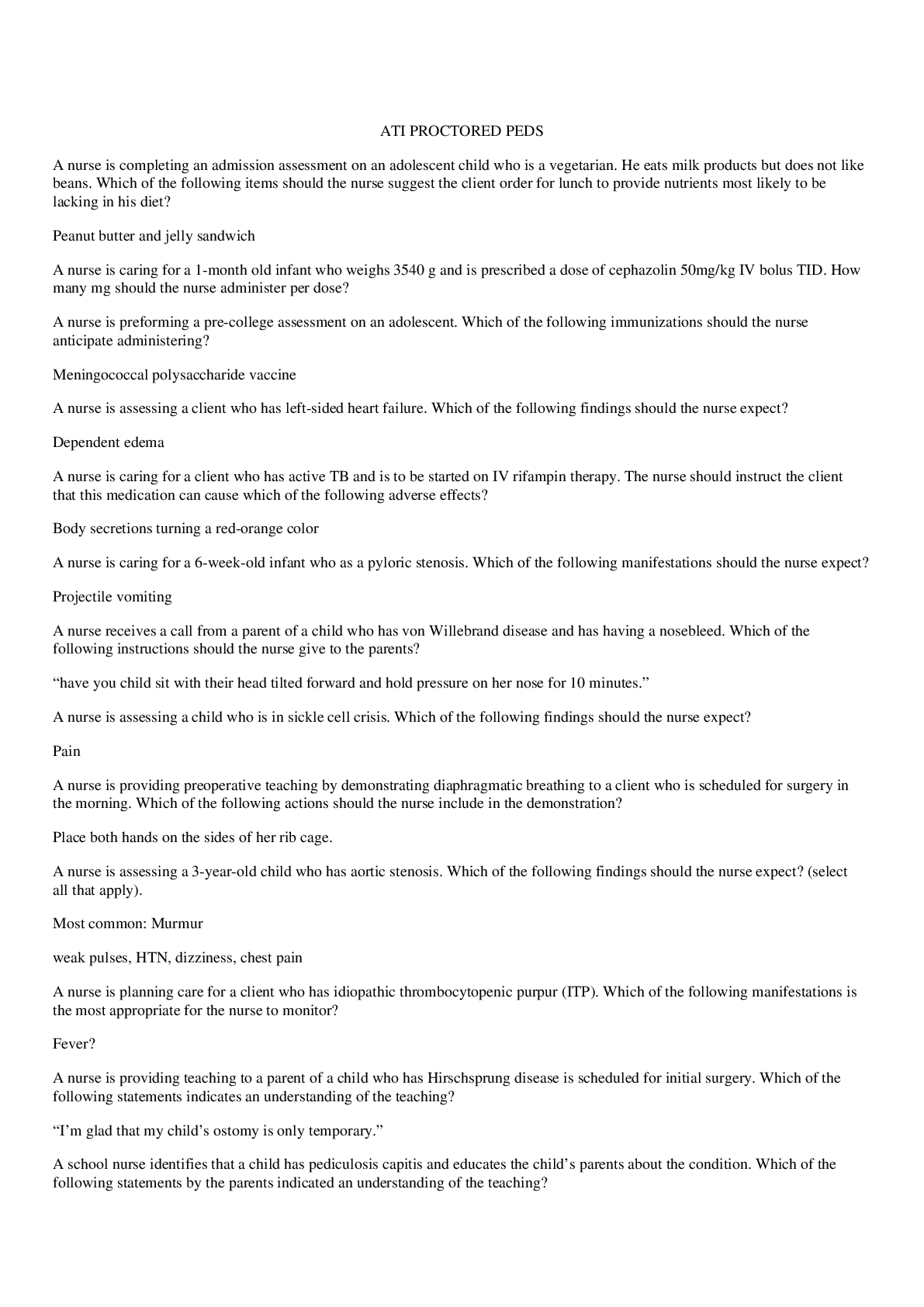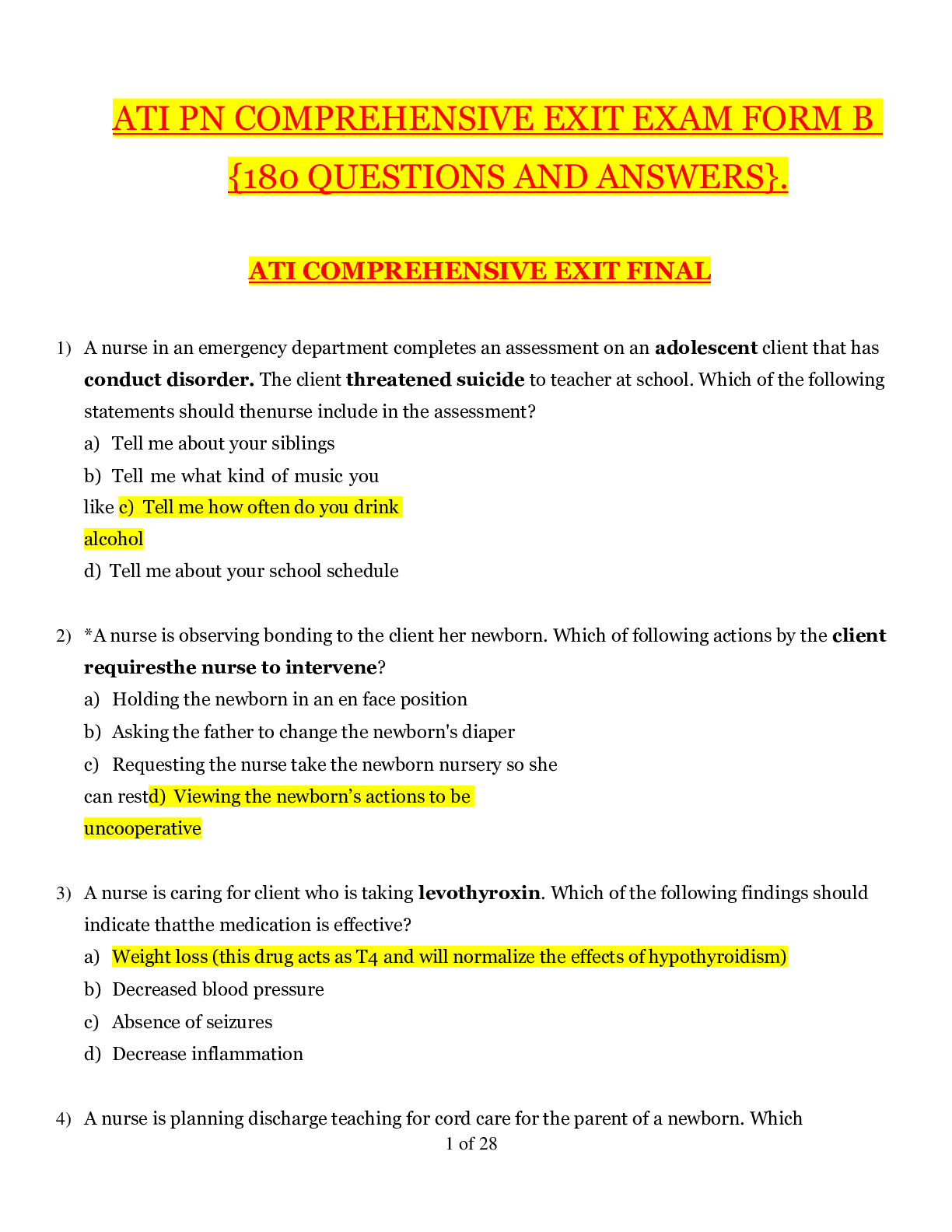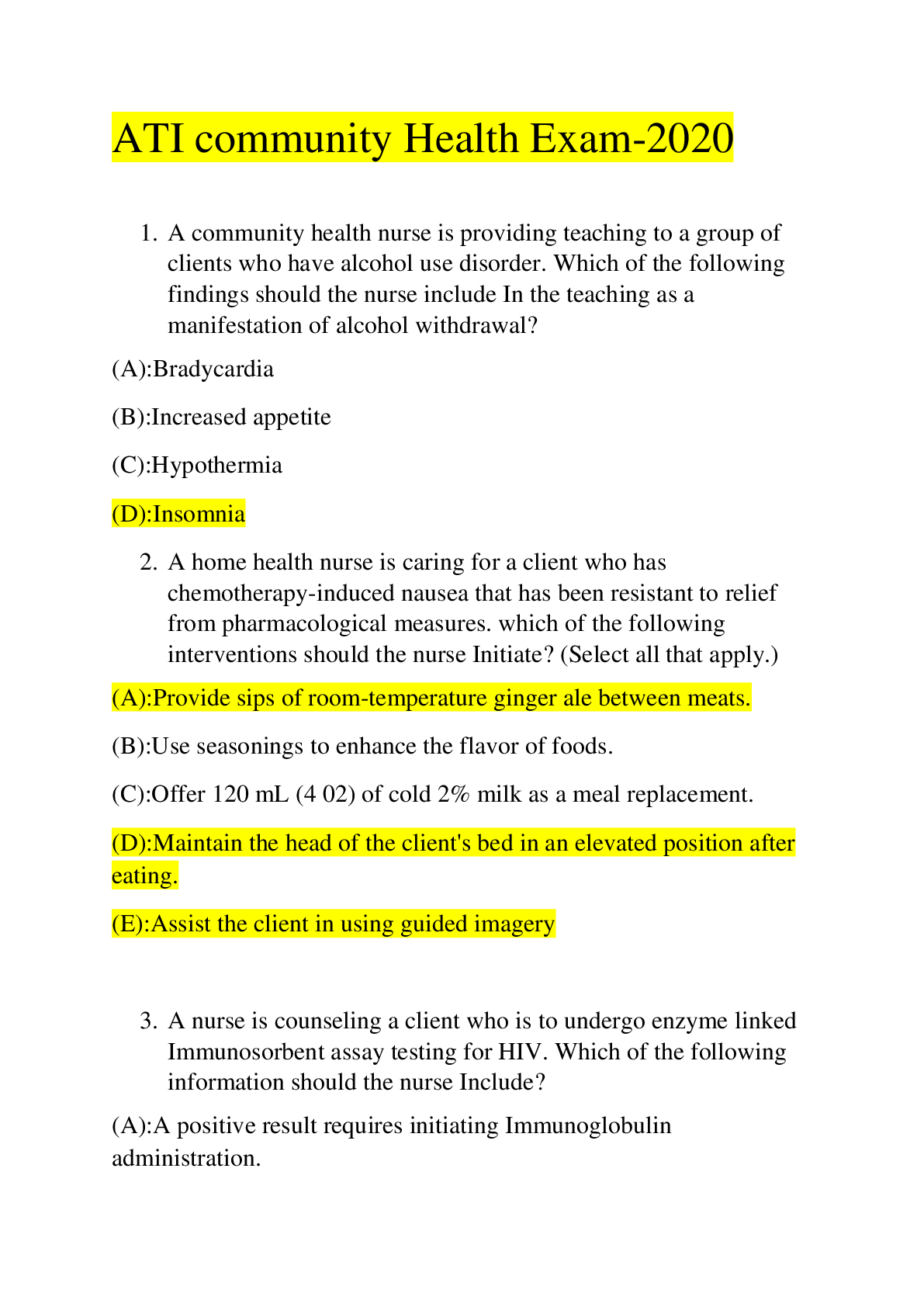*NURSING > EXAM PROCTORED > ATI Proctored Comprehensive | RN Comprehensive Predictor 2021 Form B (complete answers with 300 Qual (All)
ATI Proctored Comprehensive | RN Comprehensive Predictor 2021 Form B (complete answers with 300 Quality Revision Question you need to Pass) A+ guide.
Document Content and Description Below
1. A nurse is providing teaching about the gastrostomy tube feedings to the parents of a school age child. Which of the following instructions should the nurse take?A. Administer the feeding over 3... 0 min. B. Place the child in as supine position after the feeding. C. Charge the feeding bag and tubing every 3 days. D. Warm the formula in the microwave prior to administration. 2. A nurse is administering digoxin 0.125 mg Po to an adult client. For which of the following findings should the nurse report to the provider? A. Potassium level 4.2 mEq/L. B. Apical pulse 58/min. C. Digoxin level 1 ng/ml. D. Constipation for 2 days. 3. A nurse is caring for a client who is comatose and has advance directives that indicate the client does not want life-sustaining measures. The client’s family want the client to have life-sustaining measures. Which of the following action should the nurse take? A. Arrange for an ethics committee meeting to address the family’s concerns. B. Support the family’s decision and initiate life-sustaining measures. C. Complete an incident report. D. Encourage the family to contact an attorney. 4. A nurse is caring for a client who wears glasses. Which of the following actions should the nurse take? A. Store the glasses in a labeled case. B. Clean the glasses with hot water. C. Clean the glasses with a paper towel. D. Store the glasses on the bedside table. 5. A nurse is teaching a group of newly licensed nurses about measures to take when caring for a client who is on contact precautions. Which of the following should the nurse include in the teaching? A. Remove the protective gown after the client’s room. B. Place the client in a room with negative pressure. C. Wear gloves when providing care to the client.D. Wear a mask when changing the linens in the client’s room. 6.A nurse is planning on care for a client who is recovering from an acute myocardial infarction that occurred 3 days ago. Which of the following instructions should the nurse include? A. Perform an ECG every 12 hr. B. Place the client in a supine position while resting. C. Draw a troponin level every 4hr. D. Obtain a cardiac rehabilitation consultation. 7. The nurse is reviewing the medical record of a client who is requesting combination oral contraceptives. Which of the following conditions in the client’s history is a contradiction to the use of oral contraceptives? A. Hyperthyroidism. B. Thrombophlebitis. C. Diverticulosis. D. Hypocalcemia. 8 A nurse is caring for a client who request the creation of a living will. Which of the following actions should the nurse take? A. Schedule a meeting between the hospital ethics committee and the client. B. Evaluate the client’s understanding of life-sustaining measures. C. Determine the client’s preferences about post mortem care. D. Request a conference with the client’s family. 9.A nurse is caring for an adolescent who has sickle-cell anemia. Which of the following manifestations indicates acute chest syndrome and should be immediately reported to the provider? A. Substernal retractions. B. Hematuria. C. Temperature 37.9 C (100.2 F). D. Sneezing.10.A nurse is preforming a gastric lavage for a client who has upper gastrointestinal bleeding. Which of the .following action should the nurse take? A. Instill 500 ml of solution through the NG tube. B. Insert a large-bore NG tube. C. Use a cold irrigation solution. D. Instruct the client to lie on his right side. 11. A nurse is providing care for a client who is in the advance stage of amyotrophic lateral sclerosis. (ALS). Which of the following referrals is the nurse’s priority? A. Psychologist. B. Social worker. C. Occupational therapist. D. Speech-language pathologist. 12.A nurse is reviewing the laboratory results of a client who has rheumatoid arthritis. Which of the following findings should the nurse report to the provider? A. WBC count 8,000/mm3. B. Platelets 150,000/mm3. C. Aspartate aminotransferase 10 units/L. D. Erythrocyte sedimentation rate 75 mm/hr 13. A nurse is caring for a client who has generalized petechiae and ecchymoses. The nurse should expect a prescription for which of the following laboratory tests? A. Platelet count. B. Potassium level. C. Creatine clearance. D. Prealbumin. 14. A nurse is caring for a client following application of a cast. Which of the following actions should the nurse take first?A. Place an ice pack over the cast. B. Palpate the pulse distal to the cast. C. Teach the client to keep the cast clean and dry. D. Position the casted extremity on a pillow. 15. A nurse is caring for a client who has vision loss. Which of the following actions should the nurse take? (Select all that apply) A. Keep objects in the client’s room in the same place. B. Ensure there is high-wattage lighting in the client’s room. C. Approach the client from the side. D. Allow extra time for the client to perform tasks. E. Touch the client gently to announce presence. 16. A nurse is caring for a client who is newly diagnosed with pancreatic cancer and has questions about the disease. To research the nurse should identify that which of the following electronic database has the most comprehensive collection of nursing (Unable to read) articles? A. MEDLINE B. CINAHL. C. ProQuest. D. Health Source. 17. A nurse in an emergency department is assessing newly admitted client who is experiencing drooling and hoarseness following a burn injury. Which of the following should actions should the nurse take first? A. Obtain a baseline ECG. B. Obtain a blood specimen for ABG analysis. C. Insert an 18-gauge IV catheter. D. Administer 100% humidified oxygen. 18. A nurse is planning care for a client who has unilateral paralysis and dysphagia following a right hemispheric stroke. Which of the following interventions should the nurse include in the plan? A. Place food on the left side of the client’s mouth when he is ready to eat.B. Provide total care in performing the client’s ADLs. C. Maintain the client on bed rest. D. Place the client’s left arm on a pillow while he is sitting. 19. A nurse is caring for a client who is in a seclusion room following violent behavior. The client continues to display aggressive behavior. Which of the following actions should the nurse take?A. Confront the client about this behavior. B. Express sympathy for the client’s situation. C. Speak assertively to the client. D. Stand within 30 cm (1 ft) of the client when speaking with them. 20. A nurse is caring for a client who is receiving brachytherapy for treatment of prostate cancer. Which of the following actions should the nurse take? A. Cleanse equipment before removal from the client’s room. B. Limit the client’s visitors to 30 min per day. C. Discard the client’s linens in a double bag. Discard the radioactive source in a biohazard bag 21. A nurse is assessing a client who has left-sided heart failure. Which of the following should the nurse identify as a manifestation of pulmonary congestion? A. Frothy, pink sputum. B. Jugular vein distention. C. Weight gain. D..Bradypnea 22. A nurse is caring for a client who is in labor and requires augmentation of labor. Which of the following conditions should the nurse recognize as a contraindication to the use of oxytocin. A. Diabetes mellitus. B. Shoulder presentation. C. Postterm with oligohydramnios. (I think Maternal Newborn Chapter 15 page 100)D.Chorioamnionitis 23. A nurse is assessing a client who has left-sided heart failure. Which of the following should the nurse identify as a manifestation of pulmonary congestion? A. Frothy, pink sputum. D. Jugular vein distention. E. Weight gain. D.Bradypnea 24. A nurse is caring for a 5-month-old infant who has manifestations of severe dehydration and a prescription for paternal fluid therapy. The guardian asks. “What are the indications that my baby needs an IV?” Which of the following responses should the nurse make? A. “Your baby needs an IV because she is not producing any tears” B. “Your baby needs an IV because her fontanels are budging” C. “Your baby needs an IV because she is breathing slower than normal” D. “Your baby needs an IV because her heart rate is decreasing” 25. A nurse is providing teaching to a client who has heart failure and a new prescription for furosemide. Which of the following statements should the nurse make? A. “Taking furosemide can cause your potassium levels to be high” B. “Eat foods that are high in sodium” C. “Rise slowly when getting out of bed” D. “Taking furosemide can cause you to be overhydrated” 26. A nurse is creating a plan of care for a newly admitted client who has obsessive-compulsive disorder. Which of the following interventions should the nurse take? A. Allow the client enough time to perform rituals. B. Give the client autonomy in scheduling activities. C. Discourage the client from exploring irrational fears. D. Provide negative reinforcement for ritualistic behaviors.27. A nurse is caring for a client who has depression and reports taking ST. John’s wort along with citalopram. The nurse should monitor the client for which of the following conditions as a result of an interaction between these substances? A. Serotonin syndrome B. Tardive dyskinesia C. Pseudo parkinsonism. D. Acute dystonia. 28. A nurse is assessing a client who is receiving packed RBCs. Which of the following findings indicate fluid overload? A. Low back pain. B. Dyspnea. C. Hypotension. D. Thready pulse. 29. A nurse is calculating a client’s expected date of delivery. The client’s last menstrual period began on April . Using Nagele’s rule, what date should the nurse determine to be the client’s expected delivery date? (Use mmdd format.) 0119 date 30. A nurse is discussing group treatment and therapy with a client. The nurse should include which of the following as being a characteristic of a therapeutic group? A. The group is organized in an autocratic structure. B. The group encourages members to focus on a particular issue. (Mental Health Chapter 8 Page 42) C. The group must be led by a licensed psychiatrist. D. The group encourages clients to form dependent relationships. 31. A nurse manger is reviewing documentation with a newly licensed nurse. Which of the following notations by the newly licensed nurse indicates an understanding of the teaching.UNSURE IF ON THE REPORT A. “OOB with assistance for breakfast” B. “Given 2 mg MSO4 IM for report of pain” C. “Dressing changed qd” D. “Administered 8 u regular insulin sq.” 32. A nurse is preparing to administer eye drops to a school-age child. Identify the actions the nurse should take. (Move the steps into the box on the right, placing them in the order of performance. Use all the steps.) 1. Apply pressure to the lacrimal punctum. 2. Ask the child to look upward. 3. Pull the lower eyelid downward. 4. Instill the drops of medication. 5. Place the child in a sitting position. 5 2 3 4 1 33. A nurse is caring for a client who speaks a language different from the nurse. Which of the following should the nurse take? A. Request an interpreter of a different sex from the client. B. Request a family member or friend to interpret information for the client. C. Direct attention toward the interpreter when speaking to the client. D. Review the facility policy about the use of an interpreter. 34. A nurse is caring for a client who is in labor and is receiving oxytocin. Which of the following findings indicates that the nurse should increase the rate of infusion? ON THE REPORT needs double checking A. Urine output 20 ml/hr. B. Montevideo units constantly 300 mm Hg. C. FHR pattern with absent variability. D. Contractions every 5 min that last 30 seconds.35.A public health nurse is managing several projects for the community. Which of the following interventions should the nurse identify as a primary prevention strategy? A. Teaching parenting skills to expectant mothers and their partners. B. Conducting mental health screenings at the local community center. C. Referring client who have obesity to community exercise programs. D. Providing crisis intervention through a mobile counseling unit. 36. A nurse is preparing to administer an autologous blood product to a client. Which of the following actions should the nurse take to identify the client? A. Match the client’s blood type with the type and cross match specimens. B. Confirm the provider’s prescription matches the number on the blood component. C. Ask the client to state the blood type and the date of their last blood donation. D. Ensure that the client’s identification band matches the number on the blood unit. 37. A nurse is performing physical therapy for a client who has Parkinson’s disease. Which of the following statements by the client indicates the need for a referral to physical therapy? A. “I have been experiencing more tremors in my left arm than before” B. “I noticed that I am having a harder time holding on to my toothbrush” C. “Lately, I feel like my feet are freezing up, as they are stuck to the ground” D. “Sometimes, I feel I am making a chewing motion when I’m not eating” 38. A nurse is reviewing laboratory data for a client who has chronic kidney disease. Which of the following findings should the nurse expect? A. Increased creatine. B. Increased hemoglobin. C. Increased bicarbonate.D. Increased calcium. 39. A nurse is administering a scheduled medication to a client. The client reports that the medication appears different than what they take at home. Which of the following responses should the nurse take? A. “Did the doctor discuss with you that there was a change in this medication?” B. “I recommend that you take this medication as prescribed” C. “Do you know why this medication is being prescribed to you?” D. “I will call the pharmacist now to check on this medication” 40 A nurse is teaching at a community health fair about electrical fire prevention. Which of the following information should the nurse include in the teaching? A. Use three pronged grounded plugs. B. Cover extension cords with a rug. C. Check the tingling sensations around the cord to ensure the electricity is working. D. Remove the plug from the socket by pulling the cord. 41. A charge nurse is recommending postpartum client discharge following a local disaster. Which of the following should the nurse recommend for discharge? A. A 42-year-old client who has preeclampsia and a BP of 166/110 mm Hg. B. A 15-year-old client who delivered via emergency cesarean birth 1 day ago. C. A client who received 2 units of packed RBCs 6 hr. ago for a postpartum hemorrhage. D. A client who delivered precipitously 36 hr. ago and has a second-degree perineal laceration. 42. A nurse in a provider’s office is reviewing the laboratory results of a group of clients. Which to report? A. Herpes simplex. B. Human papillomavirus C. Candidiasis D. Chlamydia43. A nurse is providing discharge teaching for a group of clients. The nurse should recommend a referral to a dietitian A. A client who has a prescription for warfarin and states “I will need to limit how much spinach I eat”. B. A client who has gout and states, “I can continue to eat anchovies on my pizza.” C. A client who has a prescription for spironolactone and states “I will reduce my intake of foods that contain potassium”. D. A client who has (Unable to read) and states “I’ll plan to take my calcium carbonate with a full glass of water”. 44. A nurse is preparing to measure a temperature of an infant. Which of the following action should the nurse take? A. Place the tip of the thermometer under the center of the infant’s axilla. B. Pull the pinna of the infant’s ear forward before inserting the probe. C. Insert the probe 3.8 cm (1.5in) into the infant’s rectum. D. Insert the thermometer in front of the infant’s tongue. 45. A nurse in a pediatric clinic is teaching a newly hired nurse about the varicella rooster. Which of the following information should the nurse include? A. Children who have varicella are contagious until vesicles are crusted. B. Children who have varicella should receive the herpes zoster vaccination. C. Children who have varicella should be placed in droplet precaution. D. Children who have varicella are contagious 4 days before the first vesicle eruption. 46.A nurse is reviewing the laboratory report of a client who has been having lithium carbonate for the past 12 months. The nurse notes a lithium level of 0.8 mEq/L. Which of the following orders from the provider should the nurse expect? A. Withhold the next dose. B. Increase the dosage. C. Discontinue the medication.D. Administer the medication. 47. A nurse is caring for a client who has fibromyalgia and requests pain medication. Which of the following medications should the nurse administer? A. Pregabalin B. Lorazepam C. Colchicine D. Codeine. 48. A nurse is caring for a client who is to receive a transfusion of packed RBCs. Which of the following actions should the nurse take? A. Prime IV tubing with 0.9% sodium chloride. B. Use a 24-gauge IV catheter C. Obtain filter less IV tubing. D. Place blood in the warmer for 1 hr. 49. A nurse is caring for a toddler who has acute lymphocytic leukemia. In which of the following should the toddler participate? A. Looking at alphabet flashcards. B. Playing with a large plastic truck. C. Use scissors cut out paper shapes. D. Watching a cartoon in the dayroom. 50. A nurse is caring for a client who has chronic pancreatitis. Which of the following dietary recommendations should the nurse make? A. Coffee with creamer. B. Lettuce with sliced avocados. C. Broiled skinless chicken breast with brown rice.D. Warm toast with margarine. 51. A nurse is preparing to assess a 2-week-old newborn. Which of the following actions should the nurse plan to take? A. Obtain the newborn’s body temperature using a tympanic thermometer. B. (Unable to read) FACES pain scale. C. Auscultate the newborn’s apical pulse for 60 seconds. D. Measure the newborn’s head circumference over the eyebrows and below the occipital prominence. (NOT) 52. A nurse is caring for a client who is at 38 weeks gestation, is in active labor, and has ruptured membrane. Which of the following actions should the nurse take? A. Insert an indwelling urinary catheter. B. Apply fetal heart rate monitor. C. Initiate fundal massage. D. Initiate an oxytocin IV infusion. 53. A nurse is assessing a client who is 30 min postoperative following an arterial thrombectomy. Which of the following findings should the nurse to report? A. Chest pain B. Muscle spasms. C. Cool, moist skin. D. Incisional pain. 54. A nurse is completing an incident report after a client fall. Which of the following competencies of Quality and Safety Education for Nurse is the use demonstrating? A. Quality improvement. B. Patient (Unable to read) C. Evidence based practice. D. Informatics. 55. A nurse is talking with another nurse on the unit and smells alcohol on her breath. Which of the following actions should the nurse take? A. Confront the nurse about the suspected alcohol use. B. Inform another nurse on the unit about the suspected alcohol use.C. Ask the nurse to finish administering medications and then go home. D. Notify the nursing manager about the suspected alcohol use. 56. A nurse is caring for a client who has diaper dermatitis. Which of the following actions should the nurse take? A. Apply zinc oxide ointment to the irritated area. B. (Unable to read) C. Wipe stool from the skin using store bought baby wipes. D. Apply talcum powder to the irritated area. 66. A nurse is reviewing the facility’s safety protocols considering newborn abduction with the parent of a newborn. Which of the following statements indicates an understanding of the teaching? A. “Staff will apply identification band after first bath” B. “I will not publish public announcement about my baby’s birth” C. “I can remove my baby’s identification band as long as she is in my room” D. “I can leave my baby in my room while I walk in the hallway” 57. A nurse is receiving a telephone prescription from a provider for a client who requires additional medication for pain control. Which of the following entries should the nurse make in the medical record? A. “Morphine 3 mg SQ every 4 hr. PRN for pain.” B. “Morphine 3 mg Subcutaneous (Unable to read) C. “Morphine 3.0 mg sub q every 4 hr. PRN for pain.” D. “Morphine 3 mg SC q 4 hr. PRN for pain.” 58. A nurse realizes that the wrong medication has been administered to a client. Which of the following actions should the nurse take first? A. Notify the provider. B. Report the incident to the nurse manager. C. Monitor vital signs. D. Fill out an incident report. 59. A nurse is providing teaching to a client who is experiencing preterm contractions and dehydration. Which of the following statements should the nurse make?A. “Dehydration is treated with calcium supplements” B. “Dehydration can increase the risk of preterm labor” C. “Dehydration associated gastroesophageal reflux” D. “Dehydration is caused by a decreased hemoglobin and hematocrit” 60. A nurse is receiving a change-of-shift report for an adult female client who is postoperative. Which of the following client information should the nurse report? A. (Unable to read) B. (Unable to read) C. Answer might be lower platelets. D. (Unable to read) 61. A nurse manager is developing a protocol for an urgent care clinic that often cares for clients who do not speak the same language as clinical staff. Which of the following instructions should the nurse include? A. Use the client’s children to provide interpretation. B. (Answer was the nurse was going to do the interpretation) C. Offer client’s translation services for a nominal fee. D. Evaluate the clients’ understanding at regular intervals. 62 C 63 A64. C 65. D 66.CD. . 67.A . 68.B 69.A 70.C71.D 72.C 73.D 74.C75.A 76.C 77.C 78.B 79. C80. D 81. A82. B 83. A 84. A 85. A 86. C87. A 88. C 89. D 90. C 91. A92. A 93. A 94. A 95. C96. C 97. D 98. D 99. D 100. D101. A 102. B 103. B 104. D105. A 106. A 107. D 108. B 109. C 110. B111. D 112. C 113. B 114. C 115. A116. D 117. B 118. D 119. D120. A 121. C 122. A 123. A124. C 125. D 126. D 127. Intradermal Injection areas A. Buttocks.B. Upper back. C. Hamstring area. 128.A nurse is caring for a client who has experienced a right-hemispheric stroke. Which of the following are expected findings? (Select all that apply.) a. Impulse control difficulty b. Left hemiplegia c. Loss of depth perception d. Aphasia e. Lack of situational awareness 128.A nurse is caring for a client who has left homonymous hemianopsia. Which of the following is an appropriate nursing intervention? f. Teach the client to scan the right to see objects on the right side of her body. g. Place the bedside table on the right side of the bed. h. Orient the client to the food on her plate using the clock method. i. Place the wheelchair on the client’s left side. 129.A nurse is planning care for a client who has dysphagia and a new dietary prescription. Which of the following should the nurse include in the plan of care? (Select all that apply.) j. Have suction equipment available for use. k. Feed the client thickened liquids. l. Place food on the unaffected side of the client’s mouth. m. Assign an assistive personnel to feed the client slowly. n. Teach the client to swallow with her neck flexed. 130.A nurse is caring for a client who has global aphasia (both receptive and expressive.). Which of the following should the nurse include in the client’s plan of care? (Select all that apply.) o. Speak to the client at a slower rate. p. Assist the client to use flash cards with pictures. q. Speak to the client in a loud voice. r. Complete sentences that the client cannot finish. s. Give instructions one step at a time. 131.A nurse is assessing a client who has experienced a left-hemispheric stroke. Which of the following is an expected finding? t. Impulse control difficultyu. Poor judgement v. Inability to recognize familiar objects w. Loss of depth perception 132.A nurse is caring for a client who is scheduled for a thoracentesis. Prior to the procedure, which of the following actions should the nurse take? a. Position the client in an upright position, leaning over the bedside table. b. Explain the procedure. c. Obtain ABG’s. d. Administer benzocaine spray. 133.A nurse is reviewing ABG laboratory results of a client who is in respiratory distress. The results are pH 7.47, PaCo2 32 mm Hg. HCO3 22 mm Hg. The nurse should recognize that the client is experiencing which of the following acid-base imbalances? e. Respiratory acidosis f. Respiratory alkalosis g. Metabolic acidosis h. Metabolic alkalosis 134.A nurse is assessing a client following bronchoscopy. Which of the following findings should the nurse report to the provider? i. Blood-tinged sputum j. Dry, nonproductive cough k. Sore throat l. Bronchospasms 135.A nurse is caring for a client who is scheduled for a thoracentesis. Which of the following supplies should the nurse ensure are in the client’s room? (Select all that apply.) m. Oxygen equipment n. Incentive spirometer o. Pulse oximeter p. Sterile dressing q. Suture removal kit 136.A nurse is caring for a client following a thoracentesis. Which of the following manifestations should the nurse recognize as risks for complications? (Select all that apply.) r. Dyspnea s. Localized bloody drainage on the dressing t. Fever u. Hypotension v. Report of pain at the puncture site 137.A nurse is preparing to care for a client following chest tube placement. Which of the following items should be available in the client’s room? (Select all that apply.) a. Oxygen b. Sterile water c. Enclosed hemostat clamps d. Indwelling urinary catheter e. Occlusive dressing138.A nurse is caring for a client who has a chest tube and drainage system in place. The nurse observes that the chest tube was accidentally removed. Which of the following actions should the nurse take first? f. Obtain a chest x-ray g. Apply sterile gauze to the insertion site. h. Place tape around the insertion site. i. Assess respiratory status. 139.A nurse is assessing a client who has a chest tube and drainage system in place. Which of the following are expected findings? (Select all that apply.) j. Continuous bubbling in the water seal chamber k. Gentle constant bubbling in the suction control chamber l. Rise and fall in the level of water in the water seal chamber with inspiration and expiration m. Exposed sutures without dressing n. Drainage system upright at chest level 140.A nurse is assisting a provider with the removal of a chest tube. Which of the following should the nurse instruct the client to do? o. Lie on it left side. p. Use the incentive spirometer. q. Cough at regular intervals. r. Perform the Valsalva maneuver. 141.A nurse is planning care for a client following the insertion of a chest tube and drainage system. Which of the following should be included in the plan of care? (Select all that apply.) s. Encourage the client to cough every 2 hours. t. Check the continuous bubbling in the suction chamber. u. Strip the drainage tubing every 4 hours. v. Clamp the tube once a day. w. Obtain a chest x-ray. 142.A nurse is orientation a newly licensed nurse who is caring for a client who is receiving mechanical ventilation and is receiving mechanical ventilation and is on pressure support ventilation (PSV) mode. Which of the following statements by the newly licensed nurse indicates and understanding of PSV? a. “It keeps the alveoli open and prevents atelectasis.” b. “It allows preset pressure delivered during spontaneous ventilation.” c. “It guarantees minimal minute ventilator.” d. “It delivers a preset ventilatory rate and tidal volume to the client.” 143.A nurse is caring for a client who is experiencing respiratory distress. Which of the following early manifestations of hypoxemia should the nurse recognize? (Select all that apply.) e. Confusion f. Pale skin g. Bradycardia h. Hypotension i. Elevation blood pressure. 144.A nurse is orienting a newly licensed nurse on performing routine assessment of a client who is receiving mechanical ventilation via an endotracheal tube. Which of the following information should the nurse include in the teaching? j. Apply a vest restraint if self-extubation is attempted. k. Monitor ventilator settings ever 8 hours. l. Document tube placement in centimeters at the angle of jaw. m. Assess breath sounds every 1 to 2 hours.145.A nurse is caring for a client who has dyspnea and will receive oxygen continuously. Which of the following oxygen devices should the nurse use to deliver a precise amount of oxygen to the client? n. Nonrebreather mask o. Venturi mask p. Nasal cannula q. Simple face mask 146.A nurse is planning care for a client who is receiving mechanical ventilation. Which of the following modes of ventilation that increase the effort of the client’s respiratory muscles should the nurse include in the plan of care? (Select all that apply.) r. Assist-control s. Synchronized intermittent mandatory ventilation t. Continuous positive airway pressure u. Pressure support ventilation v. Independent lung ventilation 146.A nurse is monitoring a group of clients for increased risk for developing pneumonia. Which of the following clients should the nurse expect to be at risk? (Select all that apply.) a. Client who has dysphagia b. Client who has AIDS c. Client who was vaccinated for pneumococcus and influenza 6 months ago d. Client who is postoperative and received local anesthesia. e. Client who has a closed head injury and is receiving ventilation f. Client who has myasthenia gravis 148.A nurse in a clinic is caring for a client whose partner states the client woke up this morning, did not recognize him, and did not know where she was. The client reports chills and chest pain that is worse upon inspiration. Which of the following actions is the nurse’s priority? g. Obtain baseline vital signs and oxygen saturation. h. Obtain a sputum culture. i. Obtain a complete history from the client. j. Provide a pneumococcal vaccine. 149.A nurse is caring for a client who has pneumonia. Assessment findings include temperature 37.8 C (100 F), respirations 30/min, blood pressure 130/76, heart rate 100/min, and SaO2 91% on room air. Prioritize the following nursing interventions. k. Administer antibiotics. (3) l. Administer oxygen therapy. (1) m. Perform a sputum culture. (2) n. Administer an antipyretic medication to promote client comfort. (4) 150.A nurse in a clinic is assessing a client who has sinusitis. Which of the following techniques should the nurse use to identify manifestations of this disorder? o. Percussion of posterior lobes of lungs p. Auscultation of the trachea q. Inspection of the conjunctiva r. Palpation of the orbital areas 151.A nurse is teaching a group of clients about influenza. Which of the following client statements indicates an understanding of the teaching? s. “I should wash my hands after blowing my nose to prevent spreading the virus.” t. “I need to avoid drinking fluids if I develop symptoms.” u. “I need a flu shot every 2 years because of the different flu strains.”v. “I should cover my mouth with my hand when I sneeze.” 152.A nurse in the emergency department is caring for a client who is having an acute asthma attack. Which of the following assessments indicates that the respiratory status is declining? (Select all that apply.) a. SaO2 95% b. Wheezing c. Retraction of sternal muscles d. Pink mucous membranes e. Premature ventricular complexes (PVC’s) 153.A nurse is caring for a client 2 hours after admission. The client has an SaO2 of 91%, exhibits audible wheezes, and is using accessory muscles when breathing. Which of the following classes of medication should the nurse expect to administer? f. Antibiotic g. Beta-blocker h. Antiviral i. Beta2 agonist 154.A nurse is providing discharge teaching to a client who has a new prescription for prednisone for asthma. Which of the following client statements indicates an understanding in teaching? j. “I will decrease my fluid intake while taking this medication.” k. “I will expected to have black, tarry stools.” l. “I will take my medication with meals.” m. “I will monitor for weight loss while on this medication.” 155.A nurse is assessing a client who has a history of asthma. Which of the following factors should the nurse identify as a risk for asthma? n. Gender o. Environmental allergies p. Alcohol use q. Race 156.A nurse is reinforcing teaching with a client on the purpose of taking a bronchodilator. Which of the following client statements indicates an understanding of the teaching? r. “This medication can decrease my immune response.” s. “I take this medication to prevent asthma attacks.” t. “I need to take this medication with food.” u. “This medication has a slow onset to treat my symptoms.” 157.A nurse is providing discharge teaching to a client who has COPD and a new prescription for albuterol. Which of the following statements by the client indicates and understanding of the teaching? a. “This medication can increase my blood sugar levels.” b. “This medication can decrease my immune response.” c. “I can have an increase in my heart rate while taking this medication.” d. “I can have mouth sores while taking this medication.” 158.A nurse is preparing to administer a dose of a new prescription of prednisone to a client who has COPD. The nurse should monitor for which of the following adverse effects of this medication? (Select all that apply.) a. Hypokalemia b. Tachycardia c. Fluid retention d. Nausea e. Black, tarry stools159.A nurse is discharging a client who has COPD. Upon discharge, the client is concerned that he will never be able to leave his house now that he is on continuous oxygen. Which of the following is an appropriate response by the nurse? a. “There are portable oxygen delivery systems that you can take with you.” b. “When you go out, you can remove the oxygen and then reapply it when you get home.” c. “You probably will not be able to go out at much as you used to.” d. “Home health services will come to see you so you will not need to get out.” 160.A nurse is instructing a client on the use of an incentive spirometer. Which of the following statements by the client indicates an understanding of the teaching? a. “I will place the adapter on my finger to read my blood oxygen saturation level.” b. “I will lie on my back with my knees bent.” c. “I will rest my hand over my abdomen to create resistance.” d. “I will take in a deep breath and hold it before exhaling.” 161.A nurse is planning to instruct a client on how to perform pursed-lip breathing. Which of the following should the nurse include in the plan of care? a. Take quick breaths upon inhalation. b. Place you hand over your stomach. c. Take a deep breath in through your nose. d. Puff your cheeks upon exhalation. 162.A home health nurse is teaching a client who has active tuberculosis. The provider has prescribed the following medication regimen: isoniazid 250 mg PO daily, rifampin 500 mg PO daily, pyrazinamide 750 mg PO daily, and ethambutol 1 mg PO daily. Which of the following client statements indicate the client understands the teaching? (Select all that apply.) a. “I can substitute one medication for another if I run out because that all fight infection.” b. “I will wash my hands each time I cough.” c. “I will wear a mask when I am in a public area.” d. “I am glad I don’t have to have any more sputum specimens.” e. “I don’t need to worry where I go once I start taking my medications.” 163.A nurse is teaching a client who has tuberculosis. Which of the following statements should the nurse include in the teaching? a. “You will need to continue to take the multi-medication regimen for 4 months.” b. “You will need to provide sputum samples every 4 weeks to monitor the effectiveness of the medication.” c. “You will need to remain hospitalized for treatment.” d. “You will need to wear a mask at all times.” 164.A nurse is caring for a client who has a new diagnosis of tuberculosis and has been placed on a multi-medication regimen. Which of the following instructions should the nurse give the client related to ethambutol? a. “Your urine can turn a dark orange.” b. “Watch for a change in the sclera of your eyes.” c. “Watch for any changes in vision.” d. “Take vitamin B6 daily.”165.A nurse is preparing to administer a new prescription for isoniazid (INH) to a client who has tuberculosis. The nurse should instruct the client to report which of the following findings as an adverse effect of the medication? a. “You might notice yellowing of your skin.” b. “You might experience pain in your joints.” c. “You might notice tingling of your hands.” d. “You might experience loss of appetite.” 166.A nurse is providing information about tuberculosis to a group of clients at a local community center. Which of the following manifestations should the nurse include in the teaching? (Select all that apply.) a. Persistent cough b. Weight gain c. Fatigue d. Night sweats e. Purulent sputum 167.A nurse is caring for a group of clients. Which of the following clients are at risk for pulmonary embolism? (Select all that apply.) a. A client who has a BMI of 30 b. A female client who is postmenopausal c. A client who has a fractured femur d. A client who is a marathon runner e. A client who has chronic atrial fibrillation 168.A nurse is assessing a client who has a pulmonary embolism. Which of the following information should the nurse expect to find? (Select all that apply.) f. Bradypnea g. Pleural friction rub h. Hypertension i. Petechiae j. Tachycardia 169.A nurse is reviewing prescriptions for a client who has acute dyspnea and diaphoresis. The client states she is anxious and is unable to get enough air. Vital signs are HR 117/min, respirations 38/min, temperature 38.4 C (101.2 F), and blood pressure 100/54 mm Hg. Which of the following nursing actions is the priority? k. Notify the provider. l. Administer heparin via IV infusion. m. Administer oxygen therapy. n. Obtain a spiral CT scan. 170.A nurse is caring for a client who has a new prescription for heparin therapy. Which of the following statements by the client should indicate and immediate concern for the nurse? o. “I am allergic to morphine.” p. “I take antacids several times a day.” q. “I had a blood clot in my leg several years ago.” r. “It hurts to take a deep breath.”171.A nurse is caring for a client who is to receive thrombolytic therapy. Which of the following factors should the nurse recognize as a contraindication to the therapy? a. Hip arthroplasty 2 weeks ago b. Elevated sedimentation rate c. Incident of exercise-induced asthma 1 week ago d. Elevated platelet count 172.A nurse is assessing a client following a gunshot wound to the chest. For which of the following findings should the nurse monitor to detect a pneumothorax? (Select all that apply.) a. Tachypnea b. Deviation of the trachea c. Bradycardia d. Decreased use of accessory muscles e. Pleuritic pain 173.A nurse is reviewing the prescriptions for a client who has a pneumothorax. Which of the following actions should the nurse perform first? a. Assess the client’s pain. b. Obtain a large-bore IV needle for decompression. c. Administer lorazepam. d. Prepare for chest tube insertion. 174.A nurse is reviewing discharge instructions for a client who experienced a pneumothorax. Which for the following statement should the nurse use when teaching the client? a. “Notify the provider if you experience weakness.” b. “You should be able to return to work in 1 week.” c. “You need to wear a mask when in crowded areas.” d. “Notify your provider if you experience a productive cough.” 175.A nurse in the emergency department is assessing a client who has a suspected flail chest. Which of the following findings should the nurse expect? (Select all that apply.) a. Bradycardia b. Cyanosis c. Hypotension d. Dyspnea e. Paradoxic chest movement 176.A nurse in the emergency department is assessing a client who was in a motor vehicle crash. Findings include absent breath sounds in the left lower lobe with dyspnea, blood pressure 118/68 mm Hg, heart rate 124/min, respirations 38/min, temperature 38.6 C (101.4 F), and SaO2 92% on room air. Which of the following actions should the nurse take first?a. Obtain a chest ex-ray. b. Prepare for chest tube insertion. c. Administer oxygen via high-flow mask. d. Initiate IV access. 177.A nurse is orientation a newly licensed nurse on the purpose of administering vecuronium to a client who has acute respiratory distress syndrome (ARDS). Which of the following statements by the newly licensed nurse indicates understanding of the teaching? e. “This medication is given to treat infection.” f. “This medication is given to facilitate ventilation.” g. “This medication is given to decrease inflammation.” h. “This medication is given to reduce anxiety.” 177.A nurse is reviewing the health records of five clients. Which of the following clients are at risk for developing acute respiratory distress syndrome? (Select all that apply.) a. A client who experienced a near-drowning incident b. A client following coronary artery bypass graft surgery c. A client who has a hemoglobin of 15.1 mg/dL d. A client who has dysphagia e. A client who experienced a drug overdose 178.A nurse is planning care for a client who has severe respiratory distress system (SARS). Which of the following actions should be included in the plan of care for this client? (Select all that apply.) a. Administer antibiotics. b. Provide supplemental oxygen. c. Administer antiviral medications. d. Administer bronchodilators. e. Maintain ventilatory support. 179.A nurse is caring for a client who is receiving vecuronium for acute respiratory distress syndrome. Which of the following medications should the nurse anticipate administering with this medication? (Select all that apply.) a. Fentanyl b. Furosemide c. Midazolam d. Famotidine e. Dexamethasone 180.A nurse is orienting a newly licensed nurse on the care of a client who is to have a line placed for hemodynamic monitoring. Which of the following statements by the newly licensed nurse indicates effectiveness of the teaching? a. “Air should be instilled into the monitoring system prior to the procedure.” b. “The client should be positioned on the left side during the procedure.” c. “The transducer should be level with the second intercostal spaced after the line is placed.” d. “A chest x-ray is needed to verify placement after the procedure.” A nurse is assessing a client who is undergoing hemodynamic monitoring. The client has a CVP of 7mm Hg and a PAWP of 17 mm Hg. Which of the following findings should the nurse expect? (Select all that apply.) Poor skin turgor Bilateral crackles in the lungs c. Jugular vein distention d. Dry mucous membranes e. Hepatomegaly A nurse is teaching a client who is scheduled for an angiography. Which of the following statements should the nurse include in the teaching? “You should have nothing to eat or drink for 4 hours prior to the procedure.” “You will be given general anesthesia during the procedure.” “You should not have this procedure done if you are allergic to eggs.” “You will need to keep your affected leg straight following the procedure.” A nurse at a provider’s office is reviewing the laboratory test results for a group of clients. The nurse should identify that which of the following results indicates the client is at risk for heart disease? (Select all that apply.) Cholesterol (total) 245 mg/dl HDL 90 mg/dl c. LDL 140 mg/dl Triglycerides 125 mg/dl Troponin I 0.03 ng/dl A nurse is planning care for a client who has a PICC line in the right arm. Which of the following interventions should the nurse include in the plan of care? (Select all that apply.) Use a 10 mL syringe to flush the PICC line. Apply gentle force if resistance is met during injection. e. Flush with 10 mL heparin before and after medication administration. A nurse is caring for a client who is 4 hours postoperative following coronary artery bypass grafting (CABG). He is able to inspire 200 mL with the incentive spirometer, then refuses to cough because he is tired and it hurts too much. Which of the following actions should the nurse take? Allow the client to rest and return in 1 hour. Administer IV bolus analgesic and return in 15 minutes. Document the 200 mL as an appropriate inspired volume. Tell the client that he must try to cough if he does not want to get pneumonia. A nurse is caring for a client following peripheral bypass graft surgery of the left lower extremity. Which of the following findings pose an immediate concern? (Select all that apply.) Trace of bloody drainage on dressing Capillary refill of affected limb of 6 seconds c. Mottled appearance of the limb Throbbing pain of affected limb that is decreased following IV bolus analgesic Pulse of 2+ in the affected limb A nurse educator is reviewing the use of cardiopulmonary bypass during surgery for coronary artery bypass grafting with a group of nurses. Which of the following statements should the nurse include in the discussion? (Select all that apply.) “The client’s demand for oxygen is lowered.” b. “Motion of the heart ceases.” “Rewarming of the client takes place.” “The client’s metabolic rate is increased.” “Blood flow to the heart has stopped.” A nurse is caring for a client following an angioplasty that was inserted through the femoral artery. While turning the client, the nurse discovers blood underneath the client’s lower back. Which of the following findings should the nurse suspect? Retroperitoneal bleeding Cardiac tamponade Bleeding from the incisional site Heart failure A nurses completing the admission assessment of a client who will undergo peripheral bypass graft surgery on the left leg. Which of the following findings should the nurse expect? Rubor of the affected leg when elevated 3+ dorsal pedal pulse in left foot Thin, peeling toenails of left food Report of intermittent claudication in the affected leg A nurse is admitting a client who has a suspected myocardial infarction (MI) and a history of angina. Which of the following findings will help the nurse distinguish angina from an MI? Angina can be relieved with rest and nitroglycerin. The pain of an MI resolves in less than 15 minutes. The type of activity that causes and MI can be identified. Angina can occur for longer than 30 minutes. A nurse on a cardiac unit is reviewing the laboratory findings of a client who has a diagnosis of myocardial infarction (MI) and reports that his dyspnea began 2 weeks ago. Which of the following cardiac enzymes would confirm the MI occurred 14 days ago? CK-MB Troponin I c. Troponin T d. Myoglobin A nurse is caring for a client who asks why her provider prescribed her daily aspirin. Which of the following is an appropriate response by the nurse? “Aspirin reduced the formation of blood clots that could cause a heart attack.” “Aspirin relives the pain dur to myocardial ischemia.” “Aspirin dissolves clots that are forming in your coronary arteries.” “Aspirin relives headaches that are caused by other medications.” A nurse is teaching a client who has angina about a new prescription for metoprolol. Which of the following statements by the client indicates understanding of the teaching? “I should place the tablet under my tongue.” “I should have my clotting time checked weekly.” “I will report any ringing in my ears.” “I will call my doctor if my pulse rate is less than 60.” A nurse is presenting a community education program on recommended lifestyle changes to prevent angina and myocardial infarction. Which of the following changes should the nurse recommend be made first? Diet modification Relaxation exercises c. Smoking cessation d. Taking omega-3 capsules A nurse is caring for a client who has heart failure and reports increased shortness of breath. The nurse increases the client’s oxygen per protocol. Which of the following actions should the nurse take first? Obtain the client’s weight. Assist the client into high-Fowler’s position. Auscultate lung sounds. Check oxygen saturation with pulse oximeter. A nurse is teaching a client who has heart failure about the need to lmit sodium in the diet to 2,000 mg daily. Which of the following foods should the nurse recommend for the client? (Select all that apply.) 1 slice cheddar cheese 1 medium beef hot dog c. 3 oz Atlantic salmon 3 oz roasted chicken breast 2 oz lean baked ham A nurse is completing the admission assessment of a client who has suspected pulmonary edema. Which of the following manifestations are expected findings? (Select all that apply.) Tachypnea Persistent cough Increased urinary output Thick, yellow sputum e. Orthopnea A nurse is completing discharge teaching with a client who has heart failure and is encouraged to increase potassium in his diet. Which of the following food selections should the nurse include as having the highest source of potassium? 1 medium apply 1 medium baked potato 1 slice toast with 1 tbsp peanut butter 1 large scrambled egg A nurse is providing discharge teaching for a client who has heart failure and is on fluid restriction of 2,000 ml/day. The client asks the nurse how to determine the appropriate amount of fluids he is allowed. Which of the following statements is an appropriate response by the nurse? “Pour the amount of fluid you drink into an empty 2-liter bottle to keep track of how much you drink.” “Each glass contains 8 ounces. There are 30 milters per ounce, so you can have a total of 8 glasses or cups of fluid per day.” “this is the same as 2 quarts, or about the same as two pots of coffee.” “Take sips of water or ice chips so you will not take in too much fluid.” A nurse is completing discharge teaching with a client who had a surgical placement of a mechanical heart valve. Which of the following statements by the client indicates understanding of the teaching? “I will be glad to get back to my exercise routine right away.” “I will have my prothrombin time checked on a regular basis.” “I will talk to my dentist about no longer needing antibiotics before dental exams.” “I will continue to limit my intake of foods containing potassium.” A nurse is completing the admission physical assessment of a client who has a history of mitral valve insufficiency. Which of the following findings should the nurse expect? S4 heart sound Petechiae Crackles in lung bases Splenomegaly A nurse is reviewing the health record of a client who is being evaluated for possible valvular heart disease. The nurse should recognize which of the following data as a risk factors for the condition? (Select all that apply.) Surgical repair of an atrial septal defect at age 2 Measles infection during childhood c. Hypertension for 5 years d. Weight gain of 10 lb. in the past year e. Diastolic murmur present A nurse is caring for a 72-year-old client who is to undergo a percutaneous balloon valvuloplasty. The client’s daughter asks the nurse to explain the expected outcome of the procedure. Which of the following responses should the nurse give? “This will improve blood flow in your mother’s coronary arteries.” “This will permit your mother to resume her activities of daily living.” “This will prolong your mother’s life.” “This will reverse the effects to the damaged area.” A nurse educator is reviewing expected findings in a client who has right-sided valvular heart disease with a group of nurses. Which of the following findings should the nurse include in the discussion? (Select all that apply.) Dyspnea Client report of fatigue Bradycardia Pleural friction rub e. Peripheral edema A nurse is caring for a client who has pericarditis. Which of the following findings should the nurse expect? Petechiae Murmur Rash Friction rub A nurse is caring for four clients. Which of the following clients should the nurse identify as being at risk for acquiring rheumatic endocarditis? Older adult who has chronic obstructive pulmonary disease b. Child who has streptococcal pharyngitis Middle-age adult who has lupus erythematosus Young adult who recently received body tattoo A nurse in a clinic is caring for a client who has been on long-term NSAID therapy to treat myocarditis. Which of the following laboratory findings should the nurse report to the provider? Platelets 100,000/mm3 Serum glucose 110 mg/dL Serum creatinine 0.7 mg/dL Amino alanine transferase (ALT) 30 IU/L A nurse is assessing a client who has splinter hemorrhages in her nail beds and reports a fever. The nurse should identify these findings as manifestations of which of the following disorders. Infective endocarditis Pericarditis Myocarditis Rheumatic endocarditis A nurse is admitting a client who has suspected rheumatic endocarditis. The nurse should anticipate a prescription from the provider for which of the following laboratory tests to assist in confirmation of this diagnosis? Arterial blood gases Serum albumin Liver enzymes d. Throat culture A nurse on a cardiac unit caring for a group of clients. The nurse should recognize which of the following clients as being at risk for the development of a dysrhythmia? (Select all that apply.) A client who has metabolic alkalosis A client who has a serum potassium level of 4.3 mEq/L A client who has an SaO2 of 96% d. A client who has COPD e. A client who underwent stent placement in a coronary artery. A nurse is working on a cardiac unit is admitting a client who is to undergo a cardioversion and is reviewing the health record. Which of the following data requires that the nurse notify the provider to cancel the procedure? (Review the data below for additional client information.) Ferrous Sulfate 200 mg PO 0800 and 2000 Diazepam 2 mg PO 0800 and 2000 Isosorbide 2.5 mg PO 4 times a day AC and HS Vital Signs - 0800 - T 99* F (37.2*C) Blood pressure 142/86 mmHg Heart rate 88/min and irregular Respirations 20/min History and Physical Bariatric surgery 10 years ago Dyspnea with exertion for 3 years Atrial fibrillation began 3 years ago Client reports taking the following medications for the past 6 weeks: iron supplement, multivitamin, antilipemic, and nitroglycerin Respiratory history Vital signs Medication history Medications to be administered A nurse is caring for a client who experienced defibrillation. Which of the following should be included in the documentation of this procedure? (Select all that apply.) Follow up ECG Energy settings Used IV fluid intake Urinary output Skin condition under electrodes A nurse on a cardiac unit is caring for a client who is on telemetry. The nurse recognizes the client’s heart rate is 46/min and notifies the provider. The nurse should anticipate that which of the following management strategies will be used for this client? Defibrillation Pacemaker insertion Synchronized cardioversion Administration of IV lidocaine. A student nurse is observing a cardioversion procedure and hears the team leader call out, “Stand clear”/ The student should recognize the purpose of this action is to alert personnel that The cardioverter is being charged to the appropriate setting. They should initiate CPR due to pulseless electrical activity. They cannot be in contact with equipment connected to the client. A time-out is being called to verify correct protocols. A nurse is admitting a client who has complete heart block as demonstrated by ECG. The child’s heart rate is 35/min and blood pressure is 83/48 mmHg. The client is lethargic and unable to complete sentences. Which of the following actions should the nurse perform first? Transport the client to the cardiovascular laboratory. Prepare the client for insertion of a permanent pacemaker. Obtain a signed informed consent form for a pacemaker. d. Apply transcutaneous pacemaker pads. A nurse is caring for a client following the insertion of a temporary venous pacemaker via the femoral artery that is set as a WI pacemaker rate of 70/min. Which of the following findings should the nurse report to the provider? (Select all that apply.) Cool and clammy foot with capillary refill of 5 seconds Observed pacing spike followed by a QRS complex c. Persistent hiccups Heart rate 84/min Blood pressure 104/62 mmHg A nurse is completing discharge teaching with a client who has a permanent pacemaker. Which of the following statements by the client indicates understanding of the teaching? “I will notify the airport screeners about my pacemaker.” “I will expect to have occasional hiccups.” “I will have to disconnect my garage door opened.” “I will take my pulse every 2 to 3 days.” A cardiac nurse educator is reviewing the use of the fixed rate mode pacemaker with a group of newly hired nurses. Which of the following statements by a newly hired nurse indicates understanding of the review? “This means the pacemaker fires in an asynchronous pattern.” “This means the pacemaker fires only when the heart rate is below a certain rate.” “The pacemaker can automatically adjust to a client’s increased activity level.” “The pacemaker activity is triggered by heart muscle activity.” A nurse is admitting a client to the coronary care unit following placement of a temporary pacemaker. Which of the following nursing actions should the nurse use to promote client safety? (Select all that apply.) Wear gloves when handling pacemaker leads. Ensure electronic equipment has three-pronged grounding plugs. c. Minimize the client’s shoulder movements. Hold the lead wires taut when turning the client. Keep extra pacemaker batteries at least 300 ft away from the client. A nurse is caring for a client who has chronic venous insufficiency and a prescription for thigh-high compression stockings. Which of the following actions should the nurse take? Elevate the client’s legs for 10 min, two to three times daily while wearing stockings Apply the stockings in the morning upon awakening and before getting out of bed Roll stockings down to the knees to relieve discomfort on the legs Remove the stockings while out of bed for 1 hr, four times a day, to allow the legs to rest A nurse is assessing a client who has chronic peripheral arterial disease (PAD). Which of the following findings should the nurse expect? Edema around the ankles and feet Ulceration around the medial malleoli Scaling eczema of the lower legs with stasis dermatitis Pallor on elevation of the limbs, and rubor when the limbs are dependent A nurse is teaching a client who has a new diagnosis of severe peripheral arterial disease. Which of the following instructions should the nurse include? Wear tightly-fitted insulated socks with shoes when going outside Elevate both legs above the heart when resting Apply a heating pad to both legs for comfort Place both legs in dependent position while sleeping A nurse is teaching a client who has a new prescription for clopidogrel. Which of the following instructions should the nurse include? (Select all that apply) Avoid taking herbal supplements while taking this medication b. Monitor for the presence of black, tarry stools Take this medication when you have pain Schedule a weekly PT test Limit food sources containing vitamin K while taking this medication A nurse is caring for a client who has a deep-vein thrombosis (DVT) and has been taking unfractionated heparin for 1 week. Two days ago, the provider also prescribed warfarin. The client asks the nurse about receiving both heparin and warfin at the same time. Which of the following statements should the nurse give? I will remind your provider that you are already receiving heparin Your laboratory findings that two anticoagulants were needed It takes 3 to 4 days before the therapeutic effects of warfarin are achieved, and then the heparin can be discontinued Only on of these medications is being given to treat you deep-vein thrombosis A nurse is screening a client for hypertension. The nurse should identify that which of the following actions by the client increase risk for hypertension? (select all that apply) Drinking 8 oz. nonfat milk daily Eating popcorn at the movie theater Walking 1 mile daily at 12 min/mile pace d. Consuming 36 oz beer daily e. Getting a massage once a week A nurse in an urgent care clinic is obtaining a history from a client who has type 2 diabetes mellitus and a recent diagnosis of hypertension. This is the second time in 2 weeks that the client experienced hypoglycemia. Which of the following client data should the nurse report to the provider? Takes psyllium daily as a fiber laxative Drinks skim milk daily as a bedtime snack c. Takes metoprolol daily after meals d. Drinks grapefruit juice daily with breakfast A nurse is caring for a client who is admitted to the emergency department with a blood pressure of 266/147 mm Hg. The client reports a headache and double vision. The client states, “I ran out of my diltiazem 3 days ago, and I am unable to purchase more.” Which of the following actions should the nurse take first? Administer acetaminophen for headache Provide teaching regarding the importance of not abruptly stopping an antihypertensive Obtain IV access and prepare to administer and IV antihypertensive Call social services for a referral for financial assistance in obtaining prescribed medication A nurse is providing teaching for a client who has a new diagnosis of hypertension and a new prescription for spironolactone 25 mg/day. Which of the following statements by the client indicated an understanding of the teaching? I should eat a lot of fruits and vegetables, especially bananas and potatoes b. I will report any changes in heart rate to my provider I should replace the salt shaker on my table with a salt substitute I will decrease the dose of this medication when I no longer have headaches and facial redness A nurse is providing discharge teaching for a client who has a prescription for furosemide 40 mg PO daily. The nurse should instruct the client to take this medication at which of the following times a day? Morning Immediately after lunch Immediately before dinner Bedtime Chapter 38 – ATI A nurse in the emergency department is admitting a client who has a possible dissecting abdominal aortic aneurysm. Which of the following actions is the priority for the nurse to take? Administer pain medication as prescribed Provide a warm environment Administer IV fluids as prescribed Initiate a 12-lead ECG A nurse is reviewing manifestations of a thoracic aortic aneurysm with a newly hired nurse. Which of the following findings should the nurse include in the discussion? (Select all that apply) Cough Shortness of breath Upper chest pain Diaphoresis Altered swallowing A nurse is planning postoperative care for a client following a surgical placement of an endovascular stent graft to repair and aneurysm. Which of the following interventions should the nurse include in the plan of care? (Select all that apply) Assess pedal pulses Monitor for an increase in pain below the graft site Maintain the client in high-Fowler’s position d. Monitor the femoral site for bleeding e. Report hourly urine output of 60 mL A nurse is teaching a client who has a new diagnosis of an aneurysm. The client asks the nurse to explain what causes an aneurysm to rupture. Which of the following statements should the nurse give? This can occur when the wall of an artery becomes thin and flexible This can occur when there is turbulence in blood flow in the artery It is due to abnormal enlargement d. It is due to hypertension A nurse is admitting a client who has suspected occlusion of a graft of the abdominal aorta. Which of the following manifestations should the nurse expect? Increase urine output Bounding pedal pulse Increase in abdominal girth Lower extremities have irregularly shaped cyanotic areas A nurse is reviewing bowel prep using polyethylene glycol with a client scheduled for a colonoscopy. Which of the following instructions should the nurse include in the teaching? Check with the provider about taking current medications when consuming bowel prep. Consume a normal diet until starting the bowel prep. Expect the bowel prep to not begin acting until the day after all the prep is consumed. Discontinue the bowel prep once fevers start to be expelled. A nurse is having difficulty arousing a client following esophagogastroduodenoscopy (EGD). Which of the following is the priority action by the nurse? Asses the client’s airway. Allow the client to sleep. Prepare to administer an antidote to the sedative. Evaluate preprocedural laboratory findings. A nurse in a clinic is instructing a client about a fecal occult blood test, which requires mailing three specimens. Which of the following statements by the client indicates understanding of the teaching? “I will continue taking my warfarin while I complete these tests.” “I’m glad I don’t have to follow any special diet at this time.” “This test determines if I have parasites in my bowel.” d. “This is an easy way to screen for colon cancer.” A nurse is completing preprocedural teaching for a client who will undergo a sigmoidoscopy. Which of the following information should the nurse include in the teaching? (Select all that apply.) Increased flatulence can occur following the procedure. b. NPO status should be maintained preprocedure. Conscious sedation is used. Repositioning will occur throughout the procedure. Fluid intake is limited the day after the procedure. A nurse is reviewing the health record of a client who has a suspected tumor of the jejunum. The nurse should anticipate a prescription for which of the following tests? (Select all that apply.) Serum alpha-fetoprotein Endoscopic retrograde cholangiopancreatography (ERCP) e. Colonoscopy A nurse is caring for a client following paracentesis. Which of the following findings indicate the bowel was perforated during the procedure? Client report of upper chest pain Decreased urine output Pallor Temperature elevation A nurse is planning care for a client who has a new prescription for total parenteral nutrition (TPN). Which of the following should be included in the plan of care? (Select all that apply.) Obtain a capillary blood glucose four times daily. Administer prescribed medications through a secondary port on the TPN IV tubing. Monitor vital signs three times during the 12 hour shift. d. Change the TPN IV tubing every 24 hours. e. Ensure a daily aPTT is obtained. A nurse is providing care to a client who is 1 day postoperative following a paracentesis. The nurse observes clear, pale-yellow fluid leaking from the operative site. Which of the following is an appropriate nursing intervention? Place a clean towel near the drainage site. b. Apply a dry, sterile dressing. Apply direct pressure to the site. Place the client in a supine position. A nurse is completing discharge teaching with a client who is 3 days postoperative following a transverse colostomy. Which of the following should the nurse include in the teaching? Mucus will be present in stool for 5 to 7 days after surgery. Expect 500 to 1000 mL of semi liquid stool after 2 weeks . c. Stoma should be moist and pink. d. Change the ostomy bag when it is ¾ full. A nurse is caring for a client who is receiving TPN solution. The current bag of solution was hung 24 hours ago and 400 mL remains to infuse. Which of the following is the appropriate action for the nurse to take? Remove the current bag and hang a new bag. Infuse the remaining solution at the current rate and then hang a new bag. Increase the infusion rate so the remaining solution is administered within the hour and hang a new bag. Remove the current bag and hang a bag of lactated Ringers. A nurse is caring for a client who has a new diagnosis of gastroesophageal reflux disease (GERD). The nurse should anticipate prescriptions for which of the following medications? (Select all that apply.) Antacids Histamine 2 receptor antagonists Opioid analgesics Fiber laxatives Proton pump inhibitors A nurse is admitting a client who has bleeding esophageal varices. The nurse should anticipate a prescription for which of the following medications? Propranolol Metoclopramide Ranitidine d. Vasopressin A nurse is completing an assessment of a client who has GERD. Which of the following is an expected finding? Absence of saliva Loss of tooth enamel Sweet taste in mouth Absence of eructation A nurse is teaching a client who has a hiatal hernia. Which of the following client statements indicates an understanding of the teaching? “I can take my medications with soda.” “Peppermint tea will increase my indigestion.” “Wearing an abdominal binder will limit my symptoms.” “I will drink hot chocolate at bedtime to help me sleep.” “I can lift weights as a way to exercise.” A nurse is completing discharge teaching to a client who is postoperative following fundoplication. Which of the following statements by the client indicates understanding of the teaching? “When sitting in my lounge chair after a meal, I will lower the back of it.” “I will try to eat three large meals a day.” “I will elevate the head of my bed on blocks.” “When sleeping, I will lay on my left side.” A nurse in the emergency department is completing an assessment of a client who has suspected stomach perforation due to a peptic ulcer. Which of the following findings should the nurse expect? (Select all that apply.) Rigid abdomen b. Tachycardia Elevated blood pressure Circumoral cyanosis e. Rebound tenderness A nurse is teaching a client who has a new diagnosis of dumping syndrome following gastric surgery. Which of the following information should the nurse include in the teaching? Eat three moderate-sized meals a day. Drink at least one glass of water with each meal. Eat a bedtime snack that contains a milk product. d. Increase protein in the diet. A nurse is completing discharge teaching for a client who has an infection dur to Helicobacter pylori (H. pylori). Which of the following statements by the client indicates understanding of the teaching? “I will continue my prescription for corticosteroids.” “I will schedule a CT scan to monitor improvement.” “I will take a combination of medications for treatment.” “I will have my throat swabbed to recheck for this bacteria.” A nurse is completing an assessment of a client who has a gastric ulcer. Which of the following findings should the nurse expect? (Select all that apply.) Client reports pain relieved by eating. Client states the pain often occurs at night. c. Client reports a sensation of bloating. d. Client states that pain occurs 30 minutes to 1 hour after a meal. e. Client experiences pain upon palpation of the epigastric region. A nurse is teaching a client who has a duodenal ulcer and a new prescription for esomeprazole. Which of the following information should the nurse include in the teaching? (Select all that apply.) Expect skin flushing when taking this medication. Increase river intake when taking this medication. Chew the medication thoroughly before swallowing. A nurse is teaching about pernicious anemia with a client who has chronic gastritis. Which of the following information should the nurse include in the teaching? Pernicious anemia is caused when cells producing gastric acid are damaged. b. Expect a monthly injection of vitamin B12. Plan to take vitamin K supplements. Pernicious anemia is caused by an increased production of intrinsic factor. A nurse is providing discharge teaching to a client who has a new prescription for aluminum hydroxide. Which of the following information should the nurse include in the teaching? Take the medication with food. Monitor for diarrhea. Wait 1 hour before taking other oral medications. Maintain a low-fiber diet. A nurse is planning care for a client who has acute gastritis. Which of the following nursing interventions should the nurse include in the plan of care? (Select all that apply.) Evaluate intake and output. (Select all that apply.) b. Monitor laboratory reports of electrolytes. Provide three large meals a day. Administer ibuprofen for pain. e. Observe stool characteristics. A nurse is teaching a client who has a new prescription for famotidine. Which of the following statements by the client indicates understanding of the teaching? “The medication coats the lining of the stomach.” “The medication should stop pain right away.” c. “I will take my pill 1 hour before meals.” d. “I will monitor for bleeding from my nose.” A charge nurse is teaching a group of unit nurses about a client who has chronic gastritis and is scheduled for a selective vagotomy. Which of the following statements by a unit nurse indicates understanding of the purpose of the procedure? “The client will have increased duodenal gastric emptying.” b. “The client will have a reduction of gastric acid secretions.” “The client will have an increase of gastric mucus secretion.” “The client will have an increased secretion of hydrogen/potassium ATPase enzymes.” A nurse is completing an admission assessment for a client who has a small bowel obstruction. Which of the following findings should the nurse report to the provider? (Select all that apply.) Emesis prior to insertion of the nasogastric tube b. Urine specific gravity 1.040 Hematocrit 60% Serum potassium 3.0 mEq/L WBC 10,000/uL A nurse is planning care for a client who has a small bowel obstruction and a nasogastric (NG) tube in place. Which of the following interventions should the nurse include in the plan of care? (Select all that apply.) Document the NG drainage with the client’s output. Irrigate the NG tube every 8 hours. c. Assess bowel sounds. d. Provide oral hygiene every 2 hours. e. Monitor NG tube for placement. A nurse is caring for a client who has a small bowel obstruction from adhesions. Which of the following findings are consistent with this diagnosis? (Select all that apply.) Emesis greater than 500 mL with a fecal odor. b. Report of spasmodic abdominal pain High-pitched bowel sounds Abdomen flat with rebound tenderness to palpation Laboratory findings indicating metabolic acidosis A nurse is assessing an older adult client in an extended care facility. The nurse should recognize which of the following findings is a manifestation of an obstruction of the large intestine due to a fecal impaction? The client reports he had a bowel movement yesterday. b. The client is having small, frequent liquid stools. The client is flatulent. The client indicates he vomited once this morning. A nurse is completing discharge teaching with a client who has irritable bowel syndrome (IBS). Which of the following instructions should the nurse include in the teaching? Avoid foods that trigger exacerbation. Consume 15 to 20 g of fiber daily. Plan three moderate to large meals per day. Limit fluid intake to 1 L each day. A nurse is reviewing the serum laboratory data of a client who has an acute exacerbation of Crohn’s disease. Which of the following laboratory tests should the nurse expect to be elevated? (Select all that apply.) Hematocrit Erythrocyte sedimentation rate c. WBC Folic acid Albumin A nurse is assessing a client who has been taking prednisone following an exacerbation of inflammatory bowel disease. The nurse should recognize which of the following findings as priority? Client report difficulty sleeping. The client’s urine is positive for glucose. Client reports having an elevated body temperature. Client reports gaining 4 lbs in the last 6 months. A nurse is teaching a client who has a prescription for sulfasalazine. Which of the following instructions should the nurse include in the teaching? “Take the medication 2 hours after eating.” “Discontinue this medication if your skin turns yellow-orange.” c. “Notify the provider if you experience a sore throat.” d. “Expect your stools to turn black.” A nurse is completing discharge teaching with a client who has Crohn’s disease. Which of the following instructions should the nurse include in the teaching? Decrease intake of calorie-dense foods. b. Drink canned protein supplements. Increase intake of high fiber foods. Take a bulk-forming laxative daily. A nurse in a clinic is teaching a client who has ulcerative colitis. Which of the following statements by the client indicates understanding of the teaching? “I will plan to limit fiber from my diet. “ “I will restrict fluid intake during meals.” “I will switch to black tea instead of drinking coffee.” “I will try to eat three moderate to large meals a day.” A nurse is providing discharge teaching to a client who is postoperative following opened cholecystectomy with T-tube placement. Which of the following instructions should the nurse include in the teaching? (Select all that apply) Take baths rather than showers. Clamp T-tube for 1 hour before and after meals. Keep the drainage system above the level of the abdomen. Expect to have that T-tube removed three days postoperatively Report brown green drainage to the provider A nurse is reviewing nutrition teaching for a client who has cholecystitis. The nurse should identify that which of the following food choices can trigger cholecystitis? Brownie with nets Bowl of mixed fruit Grilled Turkey Baked potato A nurse is completing preoperative teaching for a client who is scheduled for a laparoscopic cholecystectomy. Which of the following should be included in the teaching? The scope will be passed through your rectum. b. You might have shoulder pain after surgery. You will have a Jackson – Pratt drain in place after surgery. You should limit how often you walk for 1 to 2 weeks. A nurse is reviewing a new prescription for ursodiol with a client who has cholelithiasis. Which of the following information should the nurse include in the teaching? This medication is used to decrease acute biliary pain This medication requires thyroid function monitoring every six months This medication is not recommended for clients who have diabetes mellitus This medication dissolves gallstones gradually over a period of up to two years A nurse in a clinic is reviewing the laboratory reports of a client who has suspected cholelithiasis. Which of the following is an expected finding? Serum amylase 80 units/L WBC 9000/mm3 Direct bilirubin 2.1 mg/dL Alkaline phosphatease 25 units/L A nurse is completing the activation assessment of a client who has acute pancreatitis. Which of the following findings is the priority to report? History of cholelithiasis Elevated serum amylase level Decrease in bowel sounds upon auscultation He and spasms present when blood pressure is checked A nurse is preparing to administer pancrelipase to a client who has pancreatitis. Which of the following actions should the nurse take? Instruct the client to chew the medication before swallowing b. Offer a glass of water following medication administration Administer the medication 30 minutes before meals Sprinkle the content on peanut butter A nurse is completing an admission assessment of a client who has pancreatitis. Which of the following findings should the nurse expect? Pain in upper right quadrant radiating to right shoulder Report of pain being worse when sitting upright Pain relieved with defecation Epigastric pain radiating to lef t shoulder A nurse is assessing a client who has pancreatitis. Which of the following actions should the nurse take to assess the presence of Cullen’s sign. Tap Lightly at the costovertebral margin on the client back Palpate the right lower quadrant Inspect the skin around the umbilicus Auscultate the area below the scapula. A nurse is completing nutrition teaching for a client who has pancreatitis. Which of the following statements by the client indicates and understanding of the teaching? (Select all that apply) I plan to eat small, frequent meals. I will eat easy to digest foods with limited spice c. But I will use skim milk when cooking I plan to drink a regular cola I will limit alcohol intake to two drinks per day A nurse on the medical surgical unit is admitting a client who has hepatitis B with ascites. Which of the following actions should the nurse include in the plan of care? Initiate contact precautions Weigh a client weekly Measure abdominal girth 7.5 cm (3 in) above the umbilicus. d. Provide a high- calorie, high-carbohydrate diet A nurse is caring for a client who has a new diagnosis of hepatitis C. Which of the following laboratory findings should the nurse expect? Presence of immunoglobulin G antibodies (IgG) b. Positive EIA test Aspartate aminotransferase (AST) 35 units/L Alanine aminotransferase (ALT) 15 IU/L A nurse is assessing a client who has advanced cirrhosis. The nurse should identify which of the following findings as indicators of hepatic encephalopathy? (Select all that apply) Anorexia Change in orientation c. asterixis Ascites Fedor hepaticus A nurse is caring for a client who has cirrhosis. Which of the following medications can the nurse expect to administer to this client? Select all that apply. Diuretic Beta blocking agent Opioid analgesic d. Lactulos e. Sedative A nurse is teaching a client who has hepatitis B about Home Care. Which of the following instructions should the nurse include in the teaching? Select all that apply a. Limit physical activity Avoid alcohol Take acetaminophen for comfort Wear a mask when in public places e. Eat small frequent meals A nurse is teaching a client who will have an x-ray of the kidneys, ureters, and bladder. Which of the following statements should the nurse include in the teaching? “You will receive contrast dye during the procedure.” “An enema is necessary before the procedure.” “You will need to lie in a prone position during the procedure.” d. “The procedure determines whether you have a kidney stone.” A nurse is monitoring a client who had a kidney biopsy for postoperative complications. Which of the following complications should the nurse identify as causing the greatest risk to the client? Infection Hemorrhage Hematuria Pain A nurse is caring for client who has type 2 diabetes mellitus and will have excretory urography. Prior to the procedure, which of the following actions should the nurse take? (Select all that apply.) Identify an allergy to seafood. Withhold metformin for 24 hours. Administer an enema. Obtain a serum coagulation profile. e. Assess for asthma. A nurse administered captopril to a client during a renal scan. Which of the following actions should the nurse take? Assess for hypertension. Limit the client’s fluid intake. Monitor for orthostatic hypotension. Encourage early ambulation. A nurse is reviewing the results of a client’s urinalysis. The findings indicate the urine is positive for leukocyte esterase and nitrites. Which of the following actions should the nurse take? Repeat the test early the next morning. Start a 24-hour urine collection for creatinine clearance. Obtain a clean-catch urine specimen for culture and sensitivity. Insert an indwelling urinary catheter to collect a urine specimen. A nurse is teaching a client who has chronic kidney disease and is to begin hemodialysis. Which of the following information should the nurse include in the teaching? Hemodialysis restores kidney function. Hemodialysis replaces hormonal function of the renal system. Hemodialysis allows an unrestricted diet. Hemodialysis returns a balance to serum electrolytes. A nurse is preparing to initiate hemodialysis for a client who has acute kidney injury. Which of the following actions should the nurse take? (Select all that apply.) Review the medications the client currently takes. b. Assess the AV fistula for a bruit. c. Calculate the client’s hourly urine output. f. Use the access site area for venipuncture. A nurse is planning post procedure care for a client who received hemodialysis. Which of the following interventions should the nurse include in the plan of care? (Select all that apply.) Check Bun and serum creatinine. Administer medications the nurse withheld prior to dialysis. c. Observe for signs of hypovolemia. Assess the access site for bleeding. Evaluate blood pressure on the arm with AV access. A nurse is caring for a client who develops disequilibrium syndrome after receiving hemodialysis. Which of the following actions should the nurse take? Administer an opioid medication. Monitor for hypertension. Assess level of consciousness. Increase the dialysis exchange rate. A nurse is planning care for a client who will undergo peritoneal dialysis. Which of the following actions should the nurse take? (select all that apply.) Warm the dialysate in a microwave oven. Assess for shortness of breath. Check the access site dressing for wetness. Maintain medical asepsis when accessing the catheter insertion site. A nurse is assessing a client who has end-stage kidney disease. Which of the following findings should the nurse expect? (Select all that apply.) Anuria Marked azotemia Crackles in the lungs Increased calcium levels e. Proteinuria A nurse is planning postoperative care for a client following kidney transplant surgery. Which of the following actions should the nurse include in the plan of care? (Select all that apply.) Obtain daily weights. Asses dressing for bloody drainage. Replace hourly urine output with IV fluids. Expect oliguria in the first 4 hours. e. Monitor serum electrolytes. A nurse is teaching a client ho is postoperative following a kidney transplant and is taking cyclosporine. Which of the following instructions should the nurse include? “Decrease your intake of protein-rich foods.” “Take this medication with grapefruit juice.” “Monitor for and report a sore throat to your provider.” “Expect your skin to turn yellow.” A client who is scheduled for kidney transplantation surgery is assessed by the nurse for risk factors of surgery. Which of the following findings increases the client’s risk of surgery? (Select all that apply.) Age older than 70 years b. BMI of 41 c. Administering NPH insulin each morning d. Past history of lymphoma e. Blood pressure averaging 120/70 mm Hg A nurse is preoperative teaching with a client who is scheduled for a kidney transplant about rejection of a transplanted kidney. Which of the following statements should the nurse include in the teaching? (Select all that apply.) “Expect an immediate removal of the donor kidney for a hyperacute rejection.” b. “You may need to begin dialysis to monitor kidney function for a hyperacute rejection.” “A fever is a manifestation of an acute rejection.” “Fluid retention is a manifestation of an acute rejection.” “Your provider will increase your immunosuppressive medications for a chronic rejection.” A nurse is planning care for a client who has prerenal acute kidney injury (AKI) following abdominal aortic aneurysm repair. Urinary output is 60 mL in the past 2 hours, and blood pressure is 92/58 mm Hg. The nurse should anticipate which of the following interventions? Prepare the client for a CT scan with contrast dye. Plan to administer nitroprusside. Prepare to administer a fluid challenge. Plan to position the client in Trendelenburg. A nurse is planning care for a client who has postrenal AKI due to metastatic cancer. The client has a serum creatinine of 5 mg/dL. Which of the following interventions should the nurse include in the plan? (Select all that apply.) Provide a high-protein diet. b. Assess the urine for blood. Monitor for intermittent anuria. Weigh the client once per week. Provide NSAIDs for pain. A nurse is planning care for a client who has Stage 4 chronic kidney disease. Which of the following actions should the nurse include in the plan of care? (Select all that apply.) Assess for jugular vein distention. b. Provide frequent mouth rinses. Auscultate for a pleural friction rub. Provide a high-sodium diet. e. Monitor for dysrhythmias. A nurse is reviewing client laboratory dat. The nurse should recognize that which of the following findings is expected for a client who has Stage 4 chronic kidney disease? Blood urea nitrogen (BUN) 15 mg/dL Glomerular filtration rate (GFR) 20 mL/min Serum creatinine 1.1 mg/dL Serum potassium 5.0 mEq/L A nurse is assessing a client who has prerenal AKI. Which of the following findings should the nurse expect? (Select all that apply.) Reduced BUN Elevated cardiac enzymes c. Reduced urine output Elevated serum creatinine Elevated serum calcium A nurse is planning care for a client who has chronic pyelonephritis. Which of the following actions should the nurse plan to take? (Select all that apply.) Provide a referral for nutrition counseling. Encourage daily fluid intake of 1 L. c. Palpate the costovertebral angle. A nurse is caring for a client who has a urinary tract infection (UTI). Which of the following is the priority intervention by the nurse? Offer a warm sitz bath. Recommend drinking cranberry juice. Encourage increased fluids. d. Administer an antibiotic. A nurse is preparing educational material to present to a female client who has frequent urinary tract infections. Which of the following information should the nurse include? (Select all that apply.) Avoid sitting in a wet bathing suit. Wipe the perineal area back to front following elimination. Empty the bladder when there is an urge to void. Wear synthetic fabric underwear. e. Take a shower daily. A nurse is caring for several clients. Which of the following clients are at risk for developing pyelonephritis? (Select all that apply.) A client who is at 32 weeks gestation b. A client who has kidney calculi A client who has a urine pH of 4.2 A client who has a neurogenic bladder e. A client who has diabetes mellitus A nurse is reviewing urinalysis results for four clients. Which of the following urinalysis results indicates a urinary tract infection? Positive for hyaline casts Positive for leukocyte esterase Positive for ketones Positive for crystals A nurse is completing the admission assessment of a client who has renal calculi. Which of the following findings should the nurse expect? Bradycardia b. Diaphoresis Nocturia Bradypnea A nurse is reviewing discharge instructions with a client who had spontaneous passage of a calcium phosphate renal calculus. Which of the following instructions should the nurse include in the teaching? (Select all that apply.) Limit intake of food high in animal protein. Reduce sodium intake. Strain urine for 48 hours. Report burning with urination to the provider. e. Increase fluid intake to 3 L/day. A nurse is teaching a client who is scheduled for extra corporeal shock wave lithotripsy (ESWL). Which of the statements by the client indicates understanding of the teaching? “I will be fully awake during the procedure.” “Lithotripsy will reduce my chances of having stones in the future.” “I will report any bruising that occurs to my doctor.” “Straining my urine following the procedure is important.” A nurse is caring for a client who has a left renal calculus and an indwelling urinary catheter. Which of the following assessment findings is the priority for the nurse to report to the provider? Flank pain that radiates to the lower abdomen Client report of nausea Absent urine output for 1 hour Serum WBC count 15,000/mm3 A nurse is completing discharge instructions with a client who has spontaneously passed a calcium oxalate calculus. To decrease the chance of recurrence, the nurse should instruct the client to avoid which of the following foods? (Select all that apply.) Red meat b. Black tea Cheese Whole grains e. Spinach A nurse is completing preoperative teaching for a client who is to undergo an arthroscopy to repair a shoulder injury. Which of the following statements should the nurse include? (Select all that apply.) “Avoid damage or moisture to the cast on your arm.” “Keep your arm in a dependent position.” “Perform isometric exercises.” A nurse is planning care for a client who is postoperative following an arthroscopy of the knee. Which of the following actions should the nurse take? (Select all that apply.) Assess color and temperature of the extremity. Apply warm compresses to incision site. c. Place pillows under the extremity. Administer analgesic medication. Assess pulse and sensation in the foot. A nurse is teaching a client who is going to have a bone scan. Which of the following statements should the nurse include? “You will receive an injection of a radioactive isotope when the scanning procedure begins.” “You will be inside a tube-like structure during the procedure.” “You will need to take radioactive precautions with your urine for 24 hours after the procedure.” “You will need to urinate just before the procedure.” A nurse is educating clients at a health fair about dual-energy x-ray absorptiometry (DXA) scans. Which of the following information should the nurse include in the teaching? (Select all that apply.) The test requires the use of contrast material. The hip and spine are the usual areas the device scans. The scan detects osteoarthritis. Bone pain can indicate a need for a scan. At age 40 years, you should have a baseline scan. A nurse is planning care for a client who will undergo an electromyography (EMG). Which of the following actions should the nurse include in the plan of care? (Select all that apply.) Assess for bruising. Apply ice to insertion site. Determine whether the client takes a muscle relaxant. Instruct the client to flex her muscles during needle insertion. Expect swelling, redness, and tenderness at the insertion site. A nurse is reviewing the health record of a client who is to undergo total joint arthroplasty. The nurse should recognize which of the following findings as a contraindication to this procedure? Age 78 years History of cancer Previous joint replacement d. Bronchitis 2 weeks ago A nurse is admitting a client to the orthopedic unit following a total knee arthroplasty. Which of the following actions by the nurse are appropriate? (Select all that apply.) Check continuous passive motion device settings. b. Palpate dorsal pedal pulses. c. Place a pillow behind the knee. d. Elevate heels off the bed. e. Apply heat therapy to incision. A nurse is planning discharge teaching for a client who had a total hip arthroplasty. Which of the following should the nurse include in the teaching? (Select all that apply.) Clean the incision daily with soap and water. Turn the toes inward when sitting or lying. c. Sit in a straight-backed armchair. Bend at the waist when putting on socks. Use a raised toilet seat. A nurse is assessing a client who is scheduled to undergo a right knee arthroplasty. The nurse should expect which of the following findings? (Select all that apply.) Skin reddened over the joint b. Pain when bearing weight Joint crepitus Swelling of the affected joint e. Limited joint motion A nurse is completing a preoperative teaching plan for a client who is scheduled to have a total hip arthroplasty. Which of the following should the nurse include in the teaching plan? (Select all that apply.) Encourage complete autologous blood donation. Sit in a low reclining chair. Instruct the client to roll onto the operative hip. Use an abductor pillow when turning the client. Perform isometric exercises. A nurse is presenting information to a group of clients at a health fair about measures to reduce the risk of amputation. Which of the following information should the nurse provide? (Select all that apply.) Encourage client who smoke to consider smoking cessation programs. Encourage client who have diabetes mellitus to maintain blood glucose within the expected reference range. Instruct client to unplug electrical equipment when performing repairs. d. Encourage clients who have vascular disease to maintain good foot care. e. Advise clients to wait 2 hours after taking pain medication before driving. A nurse is assessing an older adult client who has arteriosclerosis and is scheduled for a possible right lower extremity amputation. Which of the following are expected findings in the affected extremity? (Select all that apply.) c. Palpable pounding pedal pulse d. Lack of hair on lower leg e. Blackened areas on several toes A nurse is caring for a client following below-the-elbow amputation. Which of the following actions should the nurse take? (Select all that apply.) Encourage dependent positioning of the residual limb b. Inspect for pressure and amount of drainage. Implement shrinkage intervention of the residual limb. Wrap the residual limb in a circular manner using gauze. e. Assess for feelings of body image changes. A nurse is caring for a client who had an above-the-knee amputation. The client reports a sharp, stabbing type of phantom pain. Which of the following actions should the nurse take? Facilitate counseling services. Encourage use of cold therapy. Question whether the pain is real. Administer an antiepileptic medication. A nurse is preparing a plan of care to prevent a client from developing flexion contractions following a below-the-knee amputation 24 hours ago. Which of the following actions should the nurse include in the plan of care? Limit any type of exercise to the residual limb for the first 48 hours after surgery . b. Position the client prone several times each day. Wrap the stump in a figure-eight pattern. Encourage sitting in a chair during the day. A nurse is admitting an older adult client who has suspected osteoporosis. Which of the following is an expected finding? (Select all that apply.) History of consuming one glass of wine daily b. Loss in height of 2 in (5.1 cm) Body mass index (BMI) of 21 Kyphotic curve at upper thoracic spine e. History of lactose intolerance A nurse is providing care for a client who had a vertebroplasty of the thoracic spine. Which of the following is an appropriate action by the nurse? Apply heat to the puncture site. Place the client in a supine position. Turn the client every 1 hour. Ambulate the client within the first hour post procedure. A nurse is providing dietary teaching about calcium-rich foods to a client who has osteoporosis. Which of the following foods should the nurse include in the instructions? White bread b. White beans White meat of chicken White rice A nurse is performing health screening at a health fair. Which of the following clients are at risk for osteoporosis? (Select all that apply.) A 40-year-old client who take prednisone for asthma A 30-year-old client who jobs 3 miles a day A nurse is planning discharge teaching on home safety for an older adult client who has osteoporosis. Which of the following information should the nurse include in the teaching? (Select all that apply.) Remove throw rugs in walkways. b. Use prescribed assistive devices. Remove clutter from the environment. Walk with caution on icy surfaces. e. Maintain lighting of doorway areas. A nurse is teaching a client how to manage an external fixation device upon discharge. Which of the following statements by the client indicates an understanding of the teaching? (Select all that apply.) “I will clean the pins twice a day.” “I will use a separate cotton swab for each pin.” c. “I will report loosening of the pins to my doctor.” d. “I will move my leg by lifting the device in the middle.” e. “I will report increased redness at the pin sites.” A nurse is assessing a client who has a casted compound fracture of the femur. Which of the following findings is a manifestation of a fat emboli? Altered mental status Reduced bowel sounds Swelling of the toes distal to the injury Pain with passive movement of the foot distal to the injury A nurse is assessing a client who had an external fixation device applied 2 hours ago for a fracture of the left tibia and fibula. Which of the following findings is a manifestation of compartment syndrome? (Select all that apply.) Intense pain when the client’s lef t foot is passively moved Capillary refill of 3 seconds on the client’s left toes Hard, swollen muscle in the client’s left leg d. Burning and tingling of the client’s left foot. e. Client report of minimal pain relief following a second dose of opioid medication A nurse is completing discharge teaching to a client who had a wound debridement for osteomyelitis. Which of the following information should the nurse include in the teaching? Antibiotic therapy should continue for 3 months. Relief of pain indicates the infection is eradicated. Airborne precautions are used during wound care. Expect paresthesia distal to the wound. A nurse in the emergency department is planning care for a client who has a right hip fracture. Which of the following immobilization devices should the nurse anticipate in the plan of care? Skeletal traction b. Buck’s traction Halo traction Brant’s traction A nurse is assessing a client who has osteoarthritis of the knees and fingers. Which of the following manifestations should the nurse expect to find? (Select all that apply.) Heberden’s nodes Swelling of all joints Small body frame A nurse is providing information to a client who has osteoarthritis of the hip and knee. Which of the following information should the nurse include in the information? (Select all that apply.) Apply heat to joints to alleviate pain. b. Ice inflamed joints following activity. c. Install an elevated toilet seat. Take tub baths. Complete high-energy activities in the morning. A nurse is providing information about capsaicin cream to a client who reports continuous knee pain from osteoarthritis. Which of the following information should the nurse include in the discussion? Continuous pain relief is provided. Inspect for skin irritation and cuts prior to application. Cover the area with tight bandages after application. Apply the medication ever 2 hours during the day. A nurse is caring for a client who injured her lower back during a fall and described sharp pain in her back and down her left leg. In which of the following positions should the nurse plan to place the client to attempt to decrease her pain? Prone without use of pillows Semi-Fowler’s with a pillow under the knees High-Fowler’s with the knees flat on the bed Supine with the head flat. A nurse is providing teaching for a client who has a history of low back injury. Which of the following instructions should the nurse give the client to prevent future problems with low back pain? (Select all that apply.) Engage in regular exercise including walking. Sit for up to 10 hours each day to rest the back. Maintain weight within 25% of ideal body weight. d. Create a smoking cessation plan. e. Wear low-heeled shoes A nurse is caring for a client who has a suspected viral skin lesion. Which of the following laboratory findings should the nurse anticipate reviewing to confirm this diagnosis? Potassium hydroxide (KOH) Diascopy Tzanck smear report Biopsy A nurse in a clinic is preparing to obtain a skin specimen from a client who has a suspected herpes infection. Which of the following actions should the nurse take? (Select all that apply) Scrape the site with a with a tongue depressors. b. Puncture the crusted area with a sterile needle. c. Swab the crusted area with a sterile cotton-tipped applicator. d. Place cotton-tipped applicators in culturette tube. e. Place call to read tube in place. A nurse is instructing a client on Home Care after a culture for a bacterial infection and cellulitis. Which of the following information should the nurse include in the teaching? Bathe daily with moisturizing soap. Apply antibacterial topical medication to the crusted exudate c. Apply warm compresses to the affected area d. Cover affected area with snug- fitting clothing A nurse is providing discharge instructions to a client who had the skin biopsy with sutures. The nurse should identify that which of the following client statements indicates that the teaching has been effective? I can expect redness around the site for 5 to 7 days I will most likely have a fever for the first few days I should apply an antibiotic the ointment to that area I will make a return appointment in three days for removal of my sutures up A nurse is providing teaching to a client about a new prescription for clotrimazole topical cream. Which of the following statements should the nurse include in the teaching? It reduces the discomfort of a herpetic infection that does not cure the infection This is a crane to treat a bacterial infection Apply the topical medication for up to two weeks after the fungal lesions are gone Apply the cream to visions while they are moist A nurse is providing information about a new prescription for corticosteroid cream to a client who has mild psoriasis. Which of the following instructions should the nurse include? (Select all that apply) Apply an occlusive dressing after application Apply 3 to 4 times per day Wear gloves after application to lesions on the hands d. Avoid applying in skin folds e. Use medication continuously over a period of several maps A nurse is teaching a client who has a history of psoriasis about photo chemotherapy and ultraviolet light (PUVA) treatments. Which of the following instructions should the nurse include in the teaching? Apply vitamin a cream before each treatment Administer psoralen medication before the treatment Use this treatment every evening Remove the scales gentle the following each treatment A nurse is educating a female client on the use of calcipotriene tropical medication for the treatment of psoriasis. Which of the following information should the nurse include? (Select all that apply) Recommended for facial lesions Expect a stinging sensation upon application c. Apply to the scalp Obtain a pregnancy test Limit application to skin folds A nurse is providing teaching to the parent of a child who has contact dermatitis. Which of the following information should the nurse include? Use fabric softener dryer sheets when drying the child’s clothing Apply a warm, dry compress to the rash area c. Place the child in a bath with colloidal oatmeal d. Leave the child scans uncovered during the night A nurse caring for a client who has contact dermatitis and has a new prescription for diphenhydramine. For which of the following adverse effects should the nurse monitor? Elevated blood glucose levels Urinary retention Hyperpigmentation of the skin Insomnia Chapter 82 A nurse is caring for a client who has blood glucose 52 mg/dL. The client is lethargic but arousable. Which of the following actions should the nurse perform first? Recheck blood glucose in 15 minutes. Provide a carbohydrate and protein food. c. Provide 4 oz grape juice. d. Report findings to the provider. A nurse is preparing to administer a morning dose of insulin as part to a client who has type 1 diabetes mellitus. Which of the following actions should the nurse implement? Check blood glucose immediately after breakfast. b. Administer insulin when breakfast arrives. Hold breakfast for 1 hour after insulin administration. Clarify the prescription because insulin should not be administered at this time. A nurse is preparing to administer morning doses of insulin glargine and regular insulin to a client who has a blood glucose 278 mg/dL. Which of the following actions should the nurse take? Draw up the regular insulin and then the glargine insulin in the same syringe. Draw up the glargine insulin then the regular insulin in the same syringe. c. Draw up and administer regular and glargine insulin in separate syringes. d. Administer the regular insulin, wait 1 hour, and then administer the glargine insulin. A nurse is presenting information to a group of clients about nutrition habits that prevent type 2 diabetes mellitus. Which of the following should the nurse include in the information? (Select all that apply.) Eat less meat and processed foods. b. Decrease intake of saturated fats. c. Increase daily fiber intake. d. Limit saturated fat into the 15% of daily caloric intake. e. Include omega-3 fatty acids in the diet. A nurse is teaching foot care to a client who has diabetes mellitus. Which of the following information should the nurse include in the teaching? (Select all that apply.) Remove calluses using over-the-counter remedies. Apply lotion between toes. Perform nail care after bathing. d. Trim toenails straight across e. Wear closed toe shoes. [Show More]
Last updated: 3 years ago
Preview 1 out of 64 pages
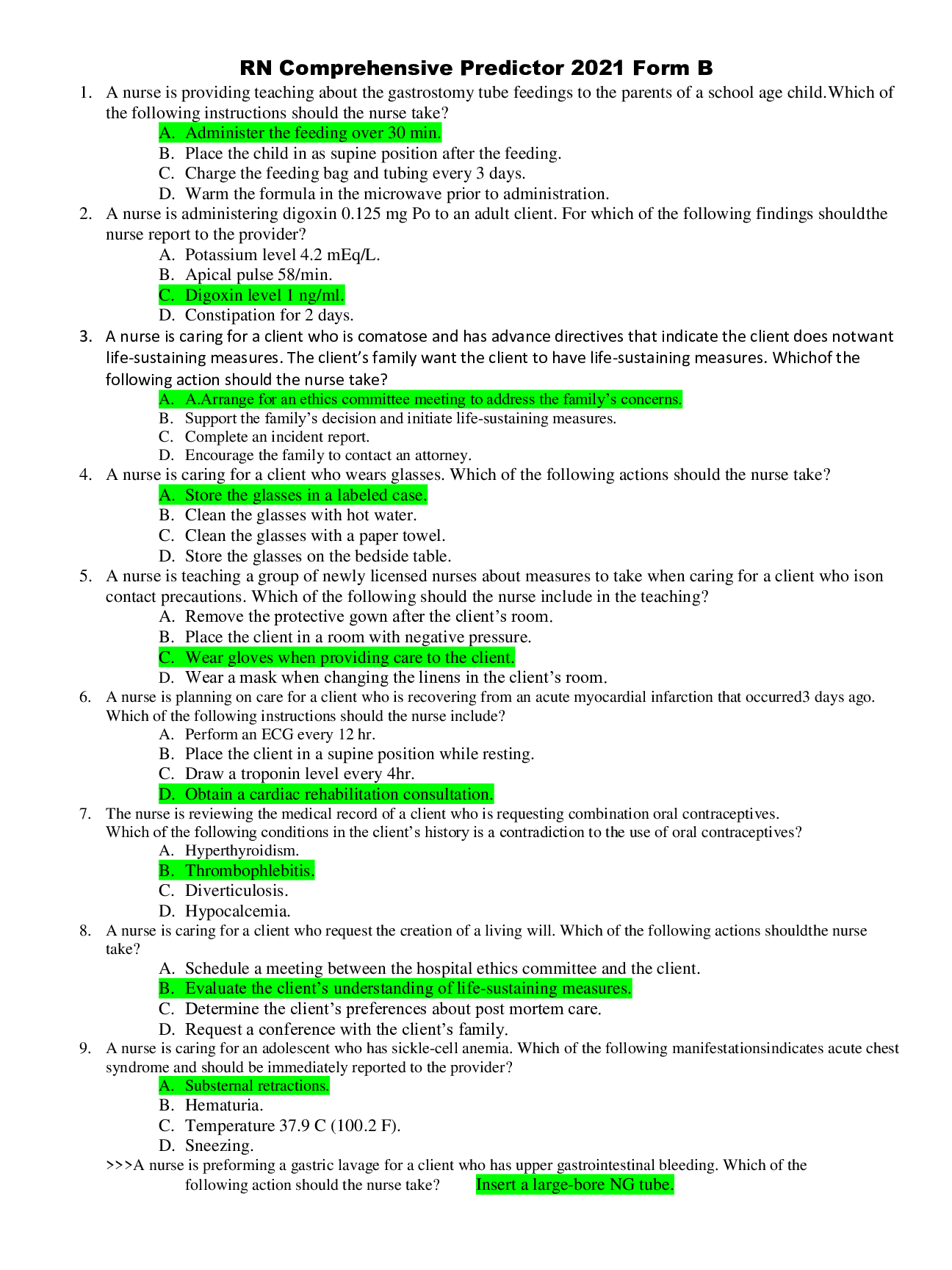
Reviews( 0 )
Document information
Connected school, study & course
About the document
Uploaded On
Mar 16, 2021
Number of pages
64
Written in
Additional information
This document has been written for:
Uploaded
Mar 16, 2021
Downloads
0
Views
84


